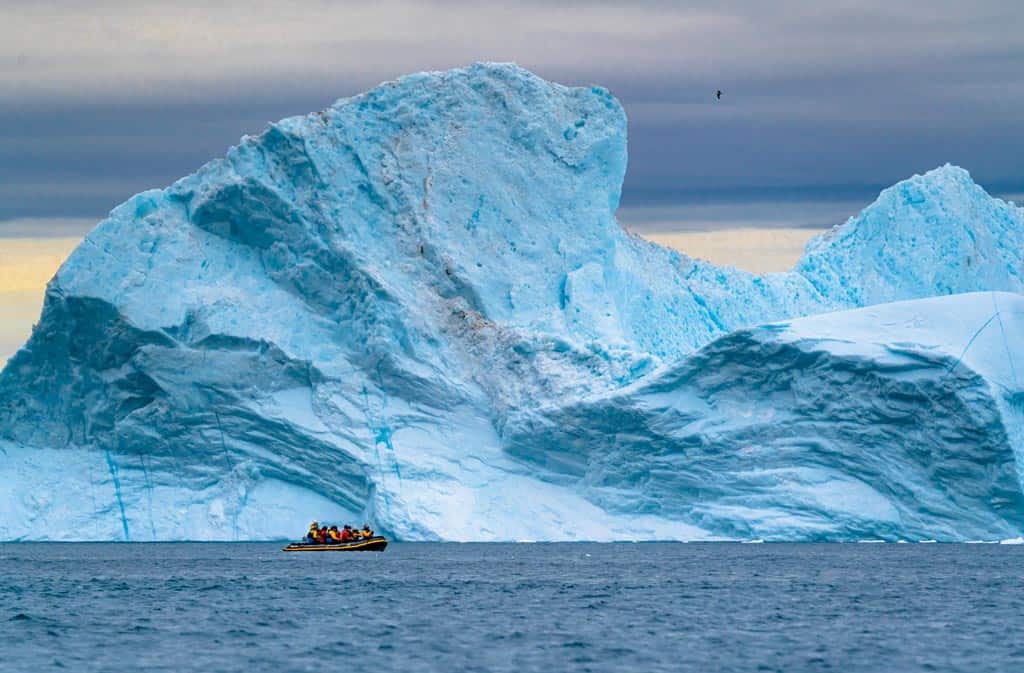Sailing through the course of history on Quark Expeditions’ Northwest Passage: In the Footsteps of Franklin voyage was a truly unforgettable experience. In our review we dive into everything we got up to, where we went and our favourite elements from this epic 17-day adventure.
In 1845 an English explorer by the name John Franklin set sail to conquer the last unknown section of the fabled Northwest Passage across the Canada Arctic.
This treacherous journey was expected to present a new trade route between the Atlantic and Pacific Oceans, opening up new possibilities for economic development.
While Franklin’s voyage eventually met disaster when his two ships, the HMS Erebus and HMS Terror, became icebound, the mystique of the Northwest Passage never faded from society.
When the Northwest Passage was finally navigated in 1903-1906 by Roald Amundsen, the sea route saw scores of seamen and soon enough, tourists, following in Franklin’s footsteps.
Today the allure of the Northwest Passage has seen it become one of most exciting destinations on the planet, with a select few expedition operators bringing intrepid travellers in search of history, culture, landscapes and wildlife.
We recently returned from our own adventure to the Canadian Arctic with the polar tour company Quark Expeditions on their ‘Northwest Passage: In the Footsteps of Franklin‘ voyage, and can attest to its captivating appeal.
In this article we break down our own experiences navigating from western Greenland into the Canadian Arctic, touching on the places we visited, the experiences we had and our overall thoughts on this fantastic and unique itinerary with Quark.
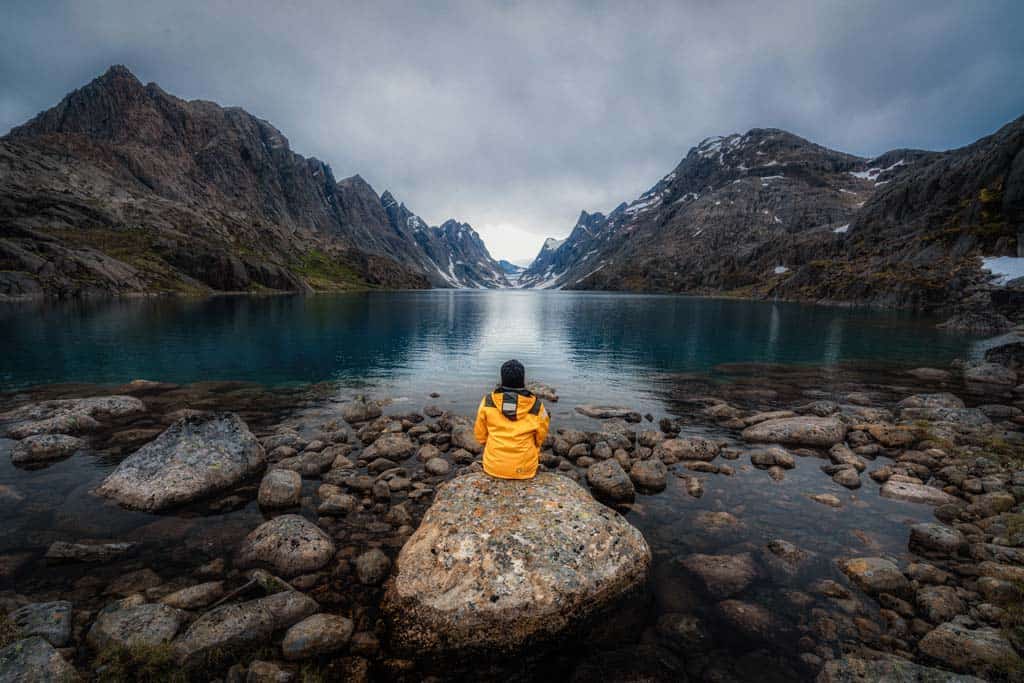
Table of Contents
- In the Footsteps of Franklin – Our Quark Expeditions Northwest Passage Review
- Visiting Local Communities and Cultural Experiences
- A Traditional Kaffemik at Inussuit Tasersuat, Greenland
- A Walking Tour of Sisimiut, Greenland
- Chasing Ice in Ilulissat, Greenland
- Music and Dance in Pond Inlet, Nunavut, Canada
- Music and Playful Kids in Arctic Bay, Nunavut, Canada
- FAQ – Are the Communities Paid for Having Cruise Ships Visit, and is This a Positive Form of Tourism?
- Crossing the Arctic Circle Line
- Transiting the Davis Straight from Greenland to Canada
- Amazing Glaciers
- Zodiac Cruises
- History Excursions
- Amazing Wildlife Encounters
- Seeing Icebergs and Sailing through Sea Ice
- Presentations by the Quark Expeditions Team
- The Ultramarine Staff
- Dining and Bar Experience on the Ultramarine
- Visiting Local Communities and Cultural Experiences
- About Quark Expeditions Polar Ship – MV Ultramarine
- Verdict on Quark Expeditions Northwest Passage: In the Footsteps of Franklin Voyage
In the Footsteps of Franklin – Our Quark Expeditions Northwest Passage Review
This incredible 17-day tour begins in Kangerlussuaq in western Greenland (after an included charter flight from Toronto in Canada) and makes it way across the Davis Strait to Baffin Island, attempting to track into the Northwest Passage and finish in Resolute, Nunavut (then flying back to Toronto).
Along the way the expedition team plans to visit remote Inuit and Greenlandic communities, explore glacial lakes, search for wildlife and dive into historic villages and landing sites from Vikings and members of Franklin’s voyage.
Quick Facts:
- Company: Quark Expeditions
- Ship: MV Ultramarine
- Duration: 17 Days
- Start: Toronto, Canada
- Arrival Airport: Kangerlussuaq, Greenland
- Departure Airport: Resolute, Nunavut
- Finish: Toronto, Canada
- Focus: Franklin’s history, Northwest Passage, wildlife, landscapes
READ MORE: Check out our full, comprehensive guide to our Quark Expeditions Greenland cruise review!
In the spirit of expedition travel an itinerary is never guaranteed, and due to the wild and ever-changing environments of the Arctic landings and exact routes are dictated by things like weather, sea ice, safety, government logistics and other elements.
We experienced this firsthand, and our itinerary did change due to all of the above. This meant that while we didn’t get to some places on the itinerary, we did get to visit some locations that we never would have seen otherwise.
This in itself makes the trip an adventure, and no two journeys are ever the same.
In this article we may talk about locations and cultural experiences that other Northwest Passage: In the Footsteps of Franklin trips don’t see, and we also didn’t have the chance to visit some other key landing sites.
If you’re considering joining Quark Expeditions on this thrilling voyage, or any of their other itineraries, keep in mind that this is just the nature of expedition travel, and the same caveat applies to all polar operators.
To be honest, that’s why we love this type of travel so much.
That being said, here are our highlights, experiences from Quark Expeditions’ Northwest Passage: In the Footsteps of Franklin voyage in Greenland and the Canadian Arctic.
EXCLUSIVE – We have partnered with the world’s top polar tour operator, Quark Expeditions, to offer readers of NOMADasaurus a very special deal on any trip to Antarctica or the Arctic! Contact us (hello@nomadasaurus.com) if you’d like to learn more.
READ MORE: Check out our full write-up on the ship we travelled on in our MV Ultramarine Review!
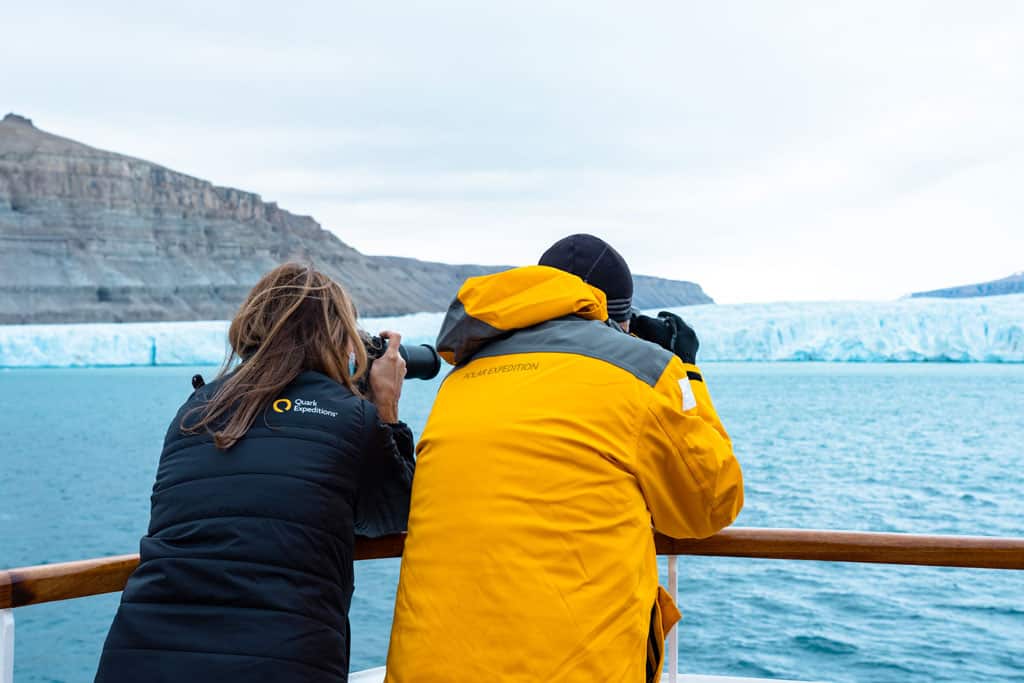
Visiting Local Communities and Cultural Experiences
Having been to Antarctica a few times in the past, we’ve always asked veterans of the industry why would somebody choose to travel to the Arctic over Antarctica.
‘The culture‘ is what they would always say, and having had the extreme fortune to visit several communities on this itinerary, we can concur that this was the most special element of the entire Northwest Passage adventure.
The Inuit people make up the majority of the population in both Greenland and the northern regions of the Canadian Arctic.
An Inuit person is also known as an Inuk, a fiercely proud and welcoming culture.
As we started in Kangerlussuaq, we had the chance to visit the towns of Ilulissat, Sisimuit, where local guides would lead us around their villages sharing the history and what life is like with the tour guests.
These colourful towns were vibrant both in appearance and culture, and not only did we have the opportunity to see firsthand what it was like here, we could also try local delicacies and purchase handmade souvenirs.
After the Greenlandic communities we sailed the Davis Strait to Baffin Island and stopped by both Pond Inlet and Arctic Bay.
While the cultures were similar to Greenland and both live off the land and sea, the economic situations were very different, and the local guides here shared the realities of living in Nunavut while also demonstrating their local music and dance.
We were so humble and grateful for these communities who let us in and shared their culture with us. It is an experience you will embrace forever.
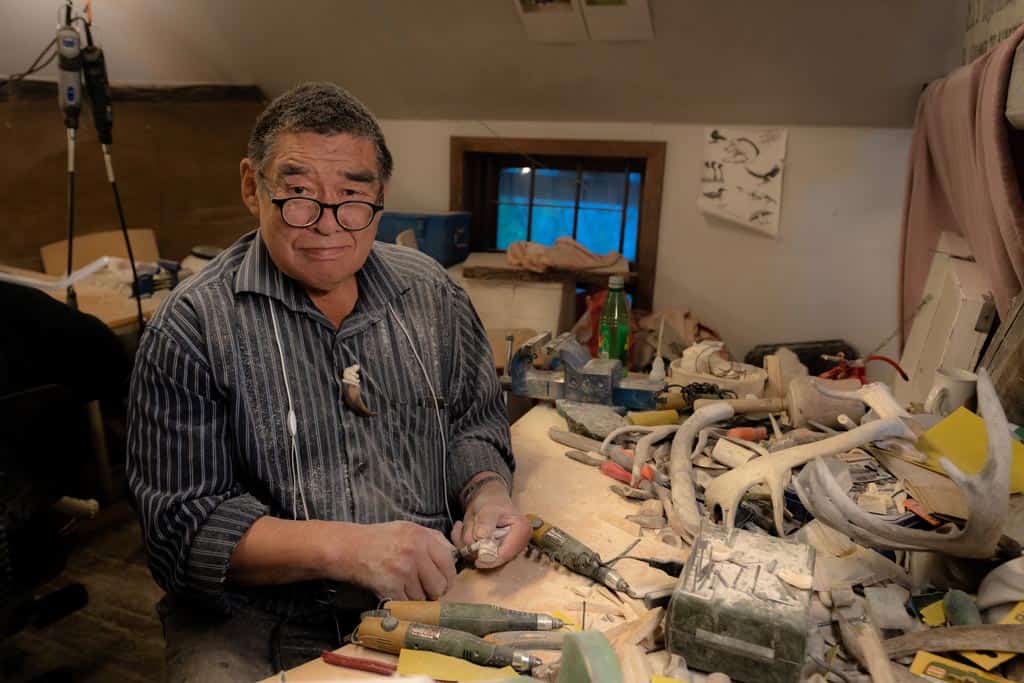
A Traditional Kaffemik at Inussuit Tasersuat, Greenland
Our first stop on the Footsteps of Franklin tour with Quark Expeditions was travelling up the west coast of Greenland and stopping off at one of the most spectacular glacial lakes we have ever seen, Inussuit Tasersuat.
We hiked up a rocky outcrop, following a river’s flow until we reached the shore of the narrow lake.
The scenery was peaceful and absolutely stunning, with jagged mountains soaring into the sky on all sides.
We spent an hour or so hanging by the lake, but one of the true highlights was being treated to a traditional Greenlandic outdoor Kaffemik (coffee or tea) and local cakes from a local family.
The local guide, Ole and his daughter had met our group by the lake and wanted to offer us snacks, which were very delicious.
They talked to the group about how they made the tea from a local plant in the area, and we all loved hearing their stories while they answered the million questions we had for them.
Ole and his daughter even taught us a few local Greenlandic words. Qujanaq, Ole!
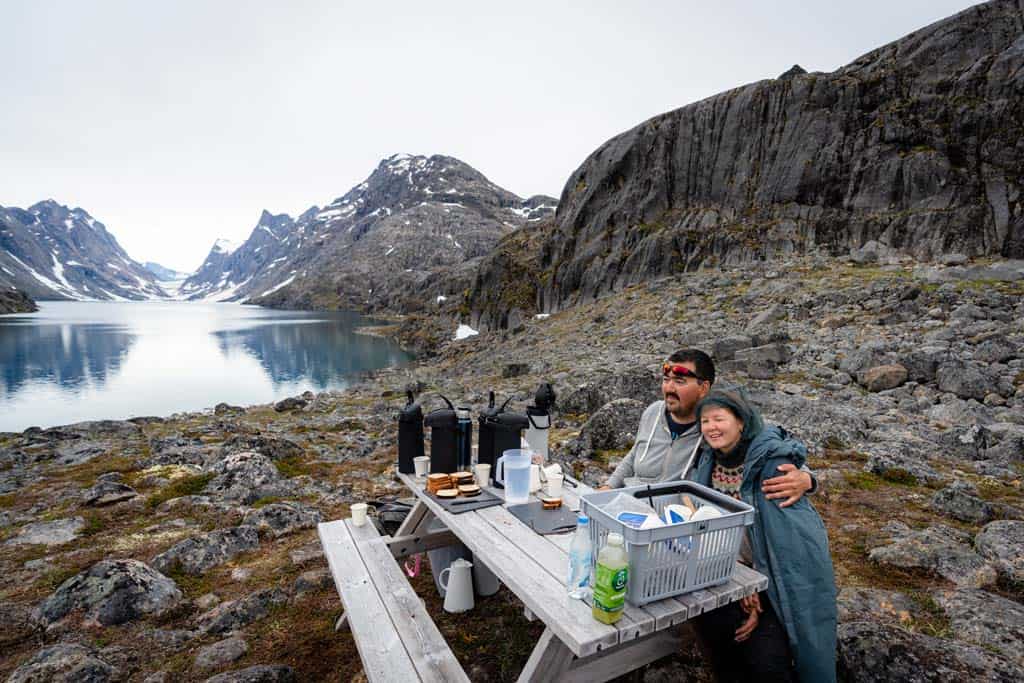
A Walking Tour of Sisimiut, Greenland
We stopped by the town of Sisimiut on the west coast of Greenland to load fuel for the journey across the Davis Strait, and rather than sit on the ship, Quark Expeditions organised for us to go on a walking tour with some local guides.
The town is surrounded by sea on one side and steep mountains on the other. It is one of the larger towns we visited, with a population of 5,500 people.
After disembarking from the ship the guests were split into their smaller zodiac groups and joined a local guide, who led us on a fascinating 2-hour walking tour of the town to learn all about the way of life here in Sisimiut.
Sismiut has so many colourful houses, which pop with contrast against the rugged landscapes.
There is also one of the oldest surviving churches in Greenland here in town. It has been restored and repainted, but still stands strong with the original structure.
The small museum exhibits photos and displays of the history of the area, with a display of a traditional Greenlandic house and traditional clothing.
After our walking tour the welcoming community greeted us with some special local delicacies.
We tried dehydrated seal meat, whale meat, and muskox meat. This is what the locals eat year round.
It is not our usual food, especially being vegetarians, but when this opportunity came up, we were first in the door to try.
We were very grateful for them sharing their food with us, which offered a unique insight into how they hunt and live in the Arctic.
With food in our bellies we headed back to the ship and were treated to a kayaking demonstration from a local hunter.
The word “kayak” is actually an Inuit word that the English language has borrowed, and it is a national symbol of Greenland.
The hunter flipped and rolled the kayak countless times, leaving us all in awe of his tremendous skills and core body strength.
As our ship sailed out of Sisimiut we waved goodbye to the community and got ready for the next cultural adventure.
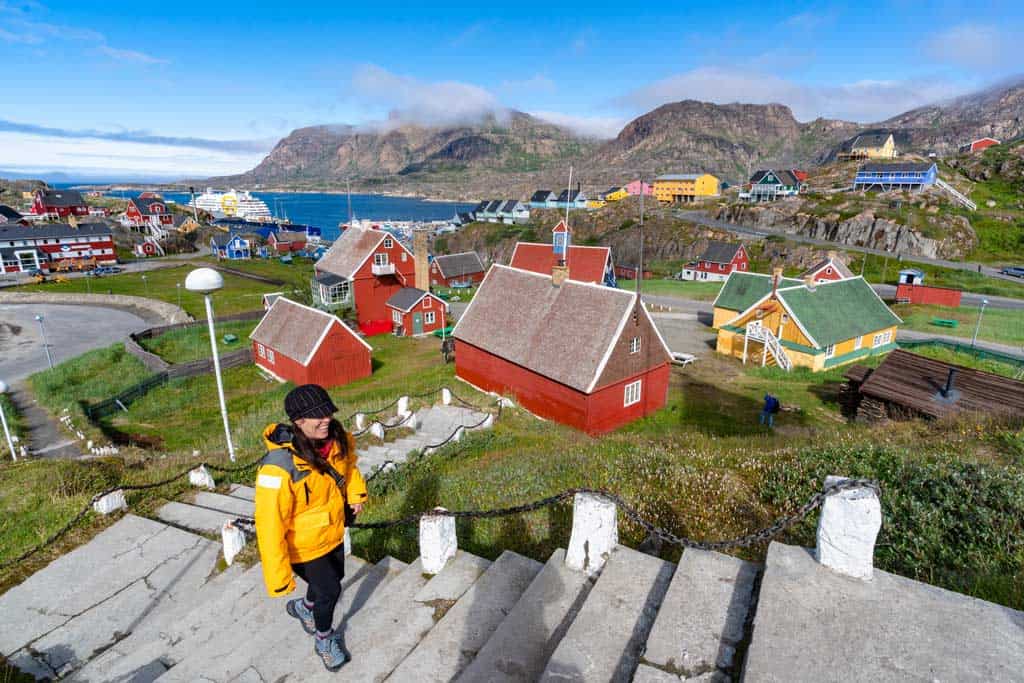
Chasing Ice in Ilulissat, Greenland
Our next stop was the colourful town of Ilulissat in Disko Bay, Greenland. This town wasn’t originally on our itinerary, but due to the change in weather down south the expedition team decided to head here, and it ended up being our favourite place in all of Greenland!
First up we walked around the gorgeous town with its iconic, colourful buildings and friendly locals.
The town is an eclectic mix of being both industrial and touristic. Ilulissat is a major working town or locals, but also draws a large portion of international tourists who want to trek and visit the UNESCO World Heritage Site, Jakobshavn Glacier, also known as Ilulissat Glacier.
Dog sledding is popular, and with the harsh winters and heavy snowfall, dog sledding is one of the most efficient ways for people to get around.
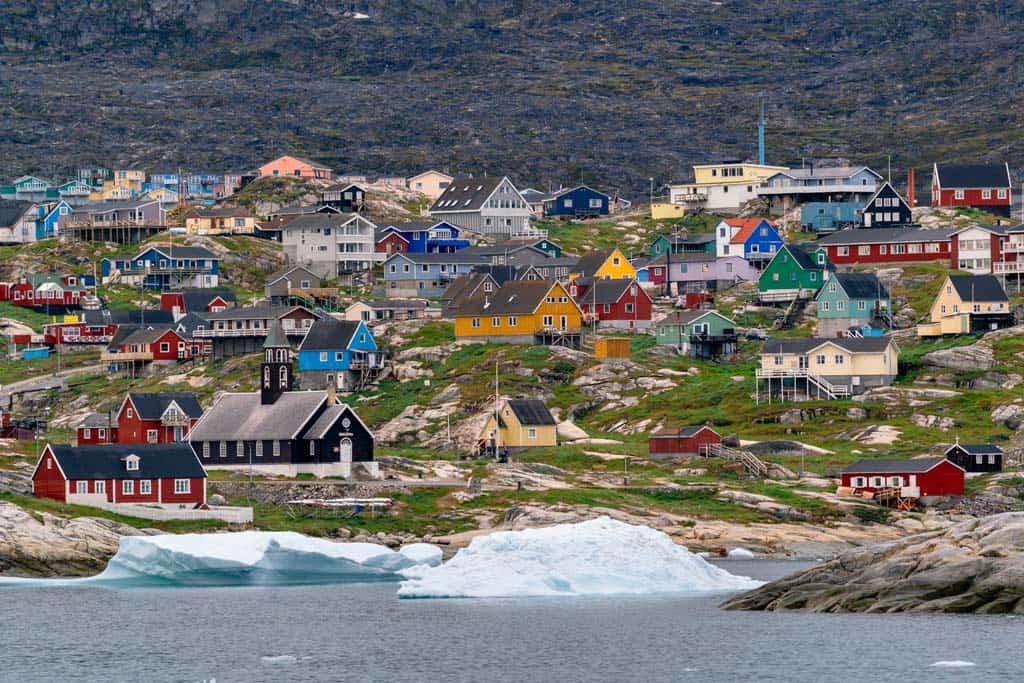
Because of this you’ll find beautiful huskies and other mushing dogs all over town. They are working dogs so it’s forbidden to pet them, and while they’re living conditions can seem harsh to us, they are well looked after here in Greenland.
This town is also famous and known for being the birthplace of explorer and anthropologist Knud Rasmussen. In the 1920’s he was the first to traverse the Northwest Passage by dogsled. They sure do breed them strong up here.
Besides the mind blowing Jakobshavn Glacier, which we talk about further below in our Northwest Passage: In the Footsteps of Franklin review, another real drawcard is the brand new Ilulissat Icefjord Centre.
This airy, modern museum dives into the science and history behind the nearby ice fjord, while discussing climate change through interactive exhibits and movies.
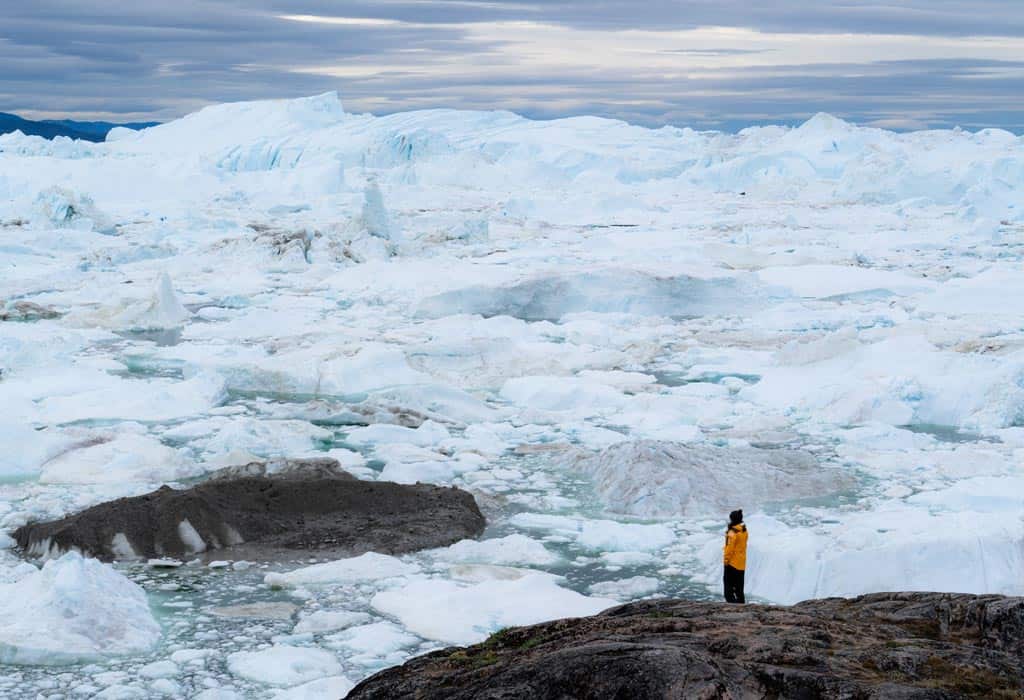
Music and Dance in Pond Inlet, Nunavut, Canada
Due to dense sea ice further south we sailed across the Davis Strait to the northern tip of Baffin Island in Nunavut.
Pond Inlet was our first destination on Baffin Island, the largest island in Canada.
After checking in through customs we disembarked from the ship and headed to shore to experience some of the local Inuit culture.
Our groups split up and we each had our own local Inuit guide to show us around the town and teach us about their lives in the Arctic – how the people live off the water, how they survive in the harsh conditions in winter and about the community.
Pond Inlet is a hunting community, and they get their food mostly from the sea.
Each person living here works together to catch their food, and they use every single bit of their catch. Many locals told us that narwal is their favourite food.
Before we left we were told that some of the locals had put together a local music and drumming demonstration in the community hall, so we wandered over to check that out.
This wasn’t just a local demonstration; It was one of the most special cultural events we’ve been to, and by the end of it there wasn’t a dry eye in the house!
The women would sing while the men would bang on their drums and dance. This is a spiritual movement is used to connect with spirits of a hunt or to ask for protection.
The drum is called a qilaut in the local Inuit language, and is made of caribou skin.
The men move their feet to imitate regional animals like the caribou, polar bear and muskox.
The performance went for over an hour, and it was such a moving, beautiful thing to experience.
Every single passenger left the show feeling as though it was a highlight of the entire trip.
To be welcomed into their local community and be shown their sacred music and dance was something we won’t ever forget. Thank you Pond Inlet.
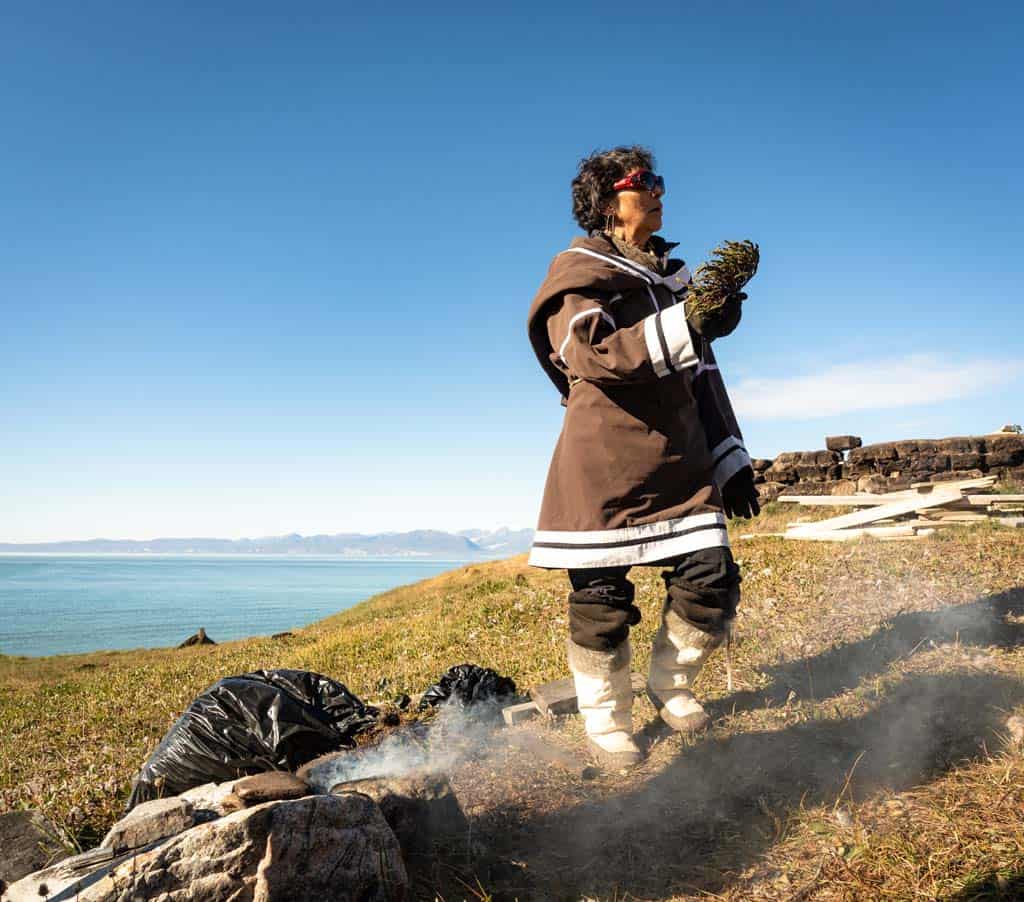
Music and Playful Kids in Arctic Bay, Nunavut, Canada
We continued on our cultural exploration of Baffin Island with a visit to the community of Arctic Bay.
We cruised to shore and some of the friendly local men and women, and all of their excited kids, welcomed us to their village.
We walked around town chatting to some of the locals, with the young kids acting as our guides, then we headed to the community centre to experience some of their traditional throat singing and drumming.
The Inuit women sing or chant with a special vocalisation technique that comes from the reverberation in the throat.
It takes many years to perfect, and is usually passed down through generations. In the local Inuit language it is called katajjaq and is considered to be one of the world’s oldest forms of music.
Two women would face each other and hold one another. The throat singing begins and they will try to outdo the other woman.
It always ends in a little giggle, showing that it’s not aggressive or competitive, but rather a form of entertainment.
Traditionally, women would do throat singing as a way to pass the time while their husbands are away hunting.
Sometimes they would use the throat singing as a lullaby to put their babies to sleep too.
When we left all of the kids came down to the shoreline and helped the expedition team push the zodiacs back into the water.
The hospitality we experienced in the Canadian Arctic was so deep, and we finally can understand what travellers mean when they say the real joy of travelling to the Arctic is the culture.
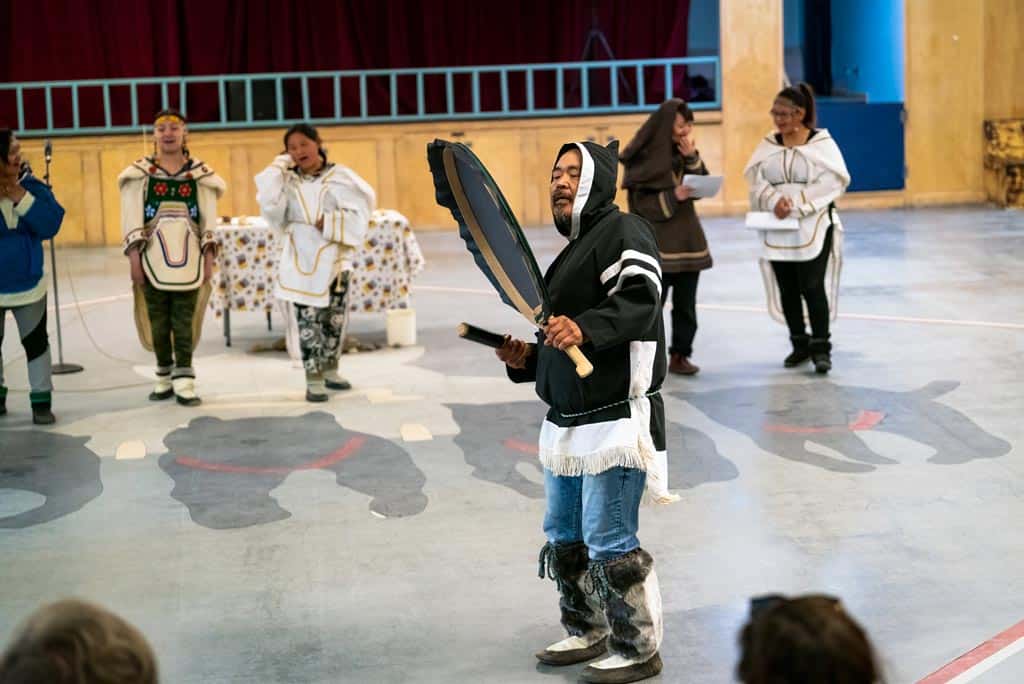
FAQ – Are the Communities Paid for Having Cruise Ships Visit, and is This a Positive Form of Tourism?
This is something all of the guests wondered – Do these remote communities genuinely enjoy or benefit from having cruise ships come into their villages?
It was a question we posed to our expedition leader during one of our daily debriefs, and he informed us that yes, Quark Expeditions pay a substantial amount of money to a community trust in order to allow their guests to visit.
All of their music demonstrations and food are also paid for by Quark so that nobody is out of pocket.
This was heartening to hear, however we also asked this to one of Quark’s expedition team members, Wayne, who is a local Inuit man from the Canadian Arctic.
In his personal opinion, having spent his whole life in the Arctic and now working as an expedition guide, he felt that our visit was overwhelmingly positive, but that there is more that polar companies* can do to further benefit these remote communities.
The money obviously is a huge help to these very remote communities, but he felt that if the ships also did supply deliveries of things like food, school supplies and medicine it would further their positive impact.
Quark Expeditions are paving the way for this kind of sustainable, community-based tourism in the Arctic, and every year they strive to do more and more to get better, even contracting local Inuit consultants to work directly with village elders. But we shouldn’t pretend that this type of tourism is perfect just yet.
Still, we honestly believe that community-based tourism, when done correctly, can be the driver of tremendous, sustainable growth and we’ve seen it firsthand in remote destinations around the world.
These remote community visits are obviously a very rewarding part of travel or those of us that don’t usually get that opportunity, and by choosing responsible operators we can help leave a positive impact on the people we encounter along the way.
*On a side note, the general consensus is that small-group trips with less than 200 passengers are much more welcome than the large cruise ships.
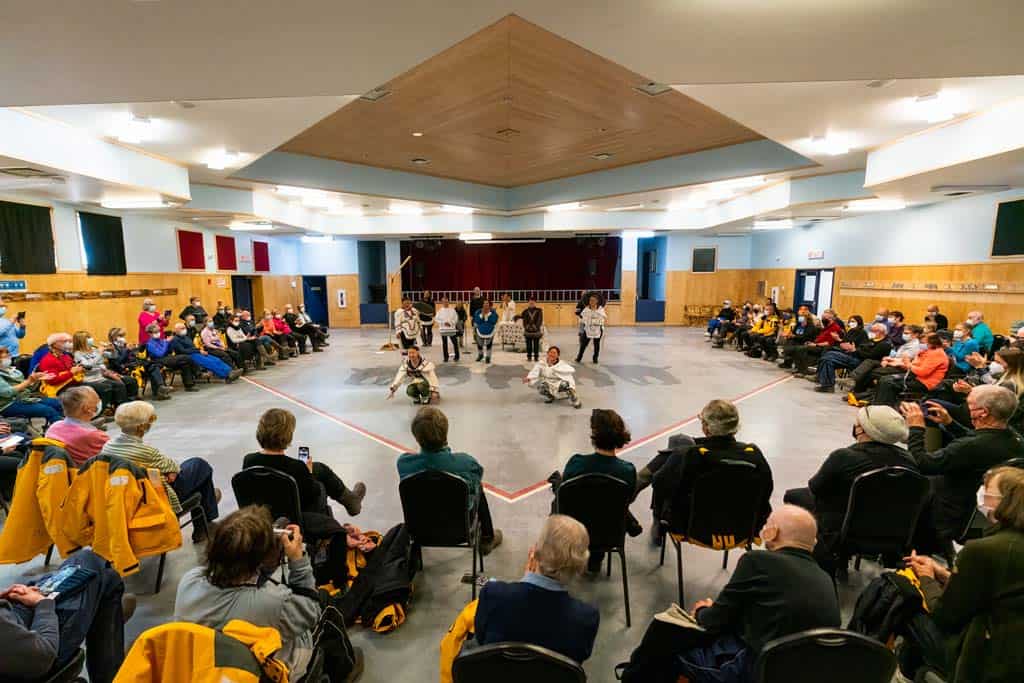
Crossing the Arctic Circle Line
An imaginary line crosses the globe at 66 degrees north, known as the Arctic Circle.
This latitude is the point on the earth where in the summer the sun never sets, providing 24 hours of daylight, while in the winter the sun never rises, casting 24 hours of darkness across the landscape.
Crossing the Arctic Circle is one of those huge bucket list items for a lot of travellers who yearn to reach the farthest corners of the globe.
During our trip towards Baffin Island the expedition leader made an announcement to let the guests know we were approaching the Arctic Circle.
Almost everybody excitedly headed to the Panorama Lounge and out onto the front deck to wait for this momentous occasion.
As the GPS ticked over to 66°30′ N, the expedition leader made the call and the guests celebrated their official foray above the Arctic Circle.
While nothing obvious changed around us, there was definitely an air of happiness that swept over the ship.
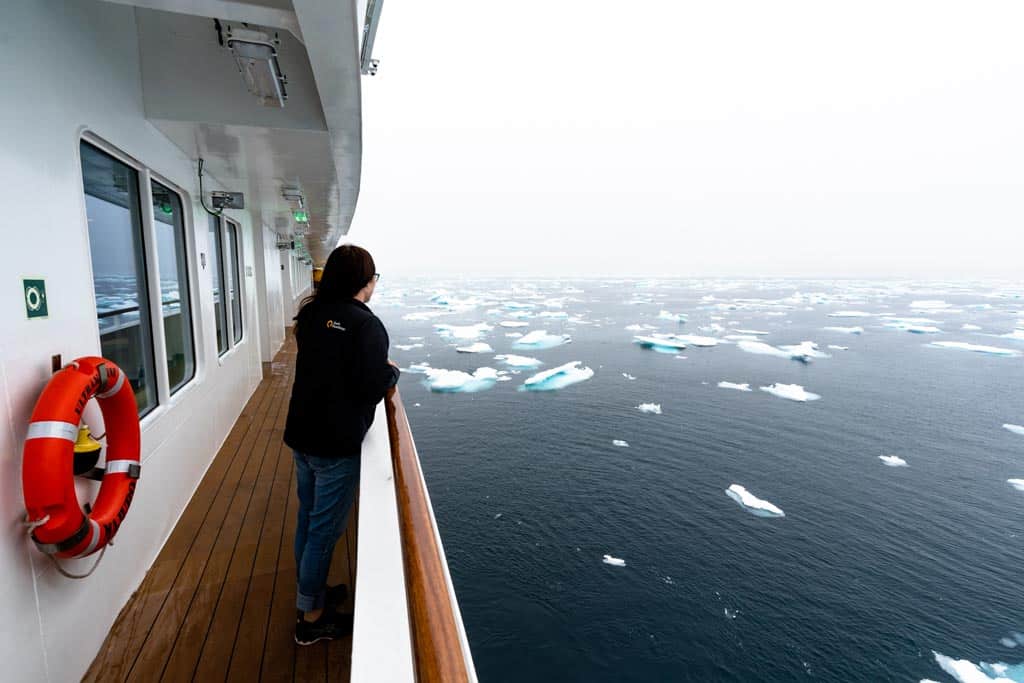
Transiting the Davis Straight from Greenland to Canada
After a week exploring Greenland the captain set the heading to northwest and navigated the Ultramarine to Baffin Island in the Canadian Arctic.
The Davis Strait is the narrow sea passage between the two continents, and home to a huge array of marine and bird life.
As we made the 2-day crossing the seas started a little rough, but that didn’t stop the passengers gathering on the decks or in the Panorama Lounge to try and spot elusive wildlife.
Many of Quark’s team, and especially their marine biologists Fabrice and Sam and the ornithologist Noah, spent all their waking hours on the deck with us, binoculars in hand, pointing out creatures as they found them.
For a few hours we encountered heavy sea ice, which the captain had been anticipating but proved to be denser than the weather forecasts suggested.
It was such a surreal sight seeing the bow of the ice-strengthened Ultramarine quietly push its way through this phenomena, and on one afternoon we actually got off the ship in zodiacs to cruise through the larger chunks of icebergs.
Many birds flew with the ship, and Sam and Fabrice managed to see whales and seals during the journey.
During one thick section of sea ice we were sitting in the Panorama Lounge enjoying a coffee when Fabrice suddenly ran inside from the deck.
“Polar bear, polar bear!!! Starboard side!”
We ran outside and sure enough right next to the ship, floating on a piece of sea ice, was a large, healthy-looking female polar bear.
We couldn’t believe our luck. On all the pieces of ice in the entire Davis Strait, we had somehow cruised right next to one with a polar bear.
And if it wasn’t for Fabrice standing on deck out in the elements, we never would have seen her.
A perfect example of why you should spend as much time as possible out in the viewing areas.
On the long sea days Quark Expeditions also put on a number of presentations held by the onboard scientists, biologists, photographers and historians to add a deeper element to the places we visited.
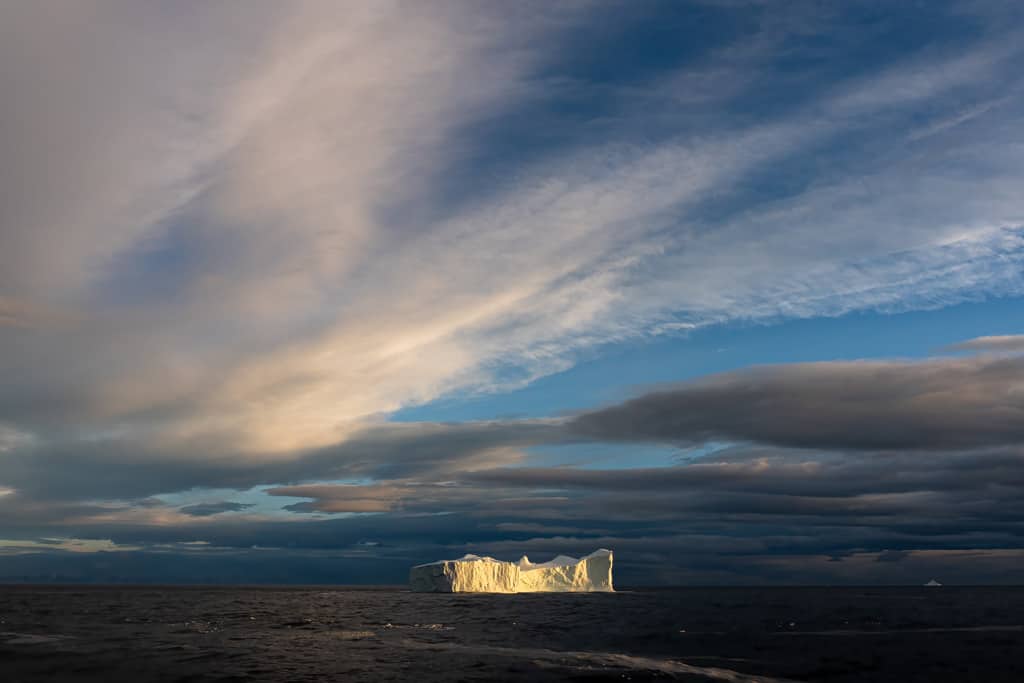
Amazing Glaciers
We have an obsession with glaciers, and on the Quark Expeditions Northwest Passage adventure we almost lost count of the amount of glaciers we saw.
With climate change having a huge, negative impact on glaciers it may not be too long before these ancient ice features are gone forever.
To us that means we cherish every time we manage to get up close to one, and on this trip the stunning beauty of the glaciers we saw was mind blowing.
Here are some of our favourite ones:
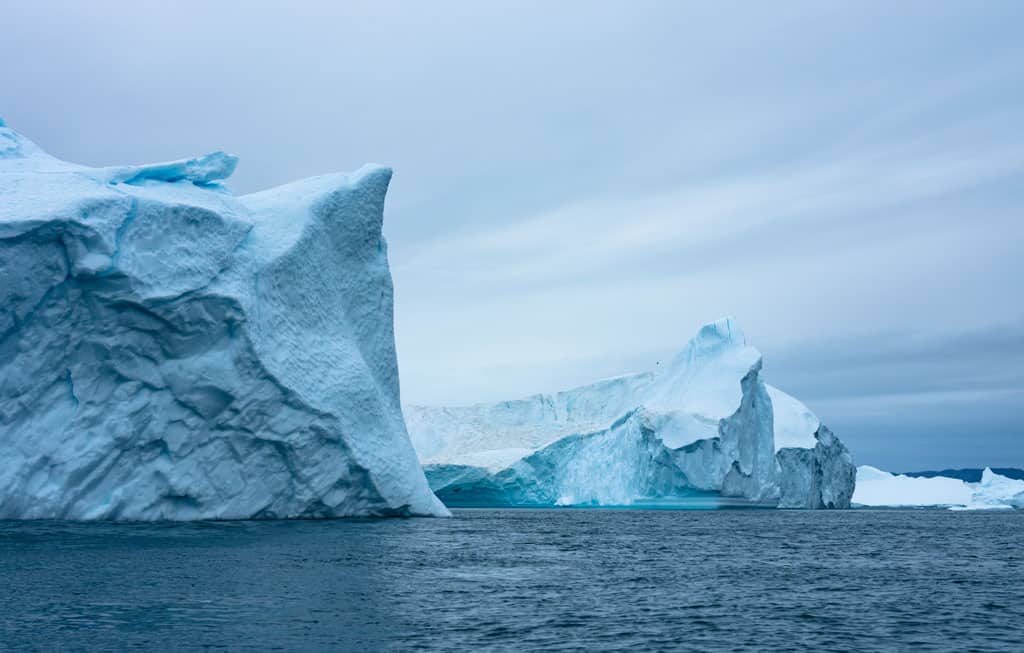
Eqip Glacier, Disko Bay, Greenland (Inuit: Equip Sermia)
Travelling along the west coast of Greenland, our itinerary changed due to a large storm in the south where we were meant to be headed.
This is just part of travelling to the polar regions – you need to be flexible and be open to whatever happens. You’re in a remote part of the world after all.
Instead of heading south, our expedition leader decided to head north to Disko Bay to escape the front, and it ended up being an incredible change.
Located on the west coast of Greenland, Disko Bay is known for being one of the most beautiful places in the Arctic, and we were so thrilled that we were now going to check it out.
This glacier is about 80 km north of the town of Ilulissat, and was our first stop when we arrived in the area.
We pulled into the bay, dropped the zodiacs and cruised to shore for a landing.
Our group hiked about 4km across beautiful tundra to get a view of the enormous Equip Sermia glacier. We climbed a steep hill and were rewarded with the most amazing sight.
Equip Sermia is one of the largest calving glaciers in Greenland, and one of the most active.
Spanning almost 4 kilometres wide and towering over 200 metres above the water, this massive glacier was so impressive to take in.
We sat up the top of the hill and watched it calve for about an hour. What a fortunate change of plans.
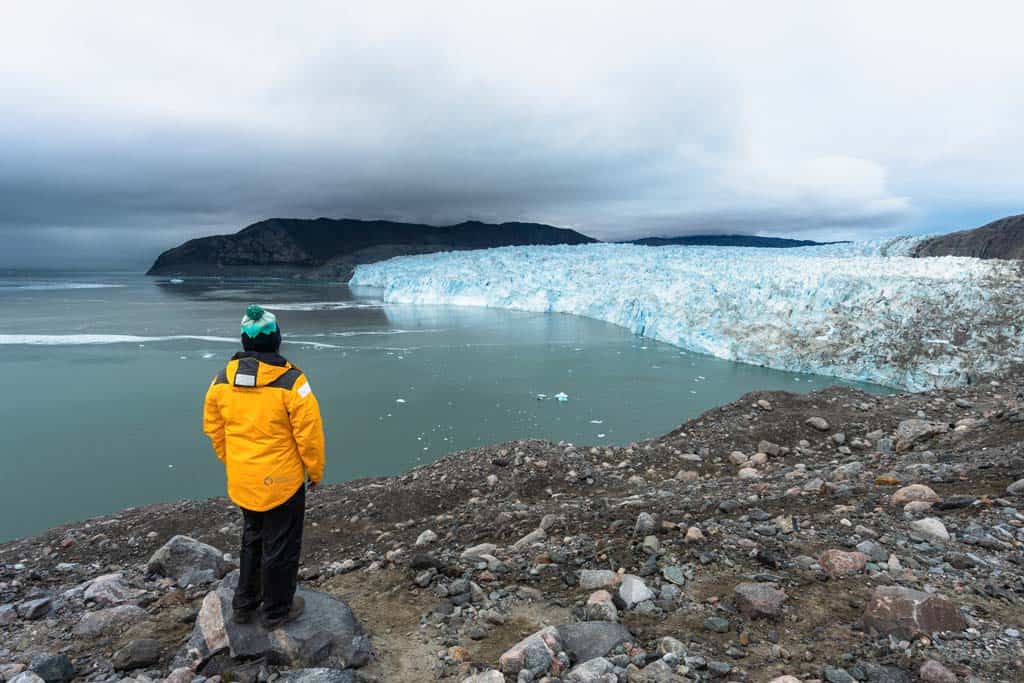
Jakobshavn Glacier, Ilulissat, Greenland (Inuit language: Sermeq Kujalleq)
Jakobshavn Glacier is located in the town of Ilulissat. It is a UNESCO World Heritage Site and also known as Ilulissat Glacier.
Jakobshavn Glacier is Greenland’s fastest-moving and also fastest-thinning glacier. It produces 10% of all of Greenland’s icebergs and drains 6.5% of the Greenland ice sheet.
After seeing the huge fjord filled with thousands of icebergs, we went on a zodiac cruise to get up close (safely of course) to these beautiful chunks of ice.
We zipped around, mesmerised by the shades of blue, and even got to see some humpback whales!! How special. And our timing was perfect as we also saw a huge chunk of ice calving into the ocean.
Hands down one of the most beautiful places we’ve been in the entire world.
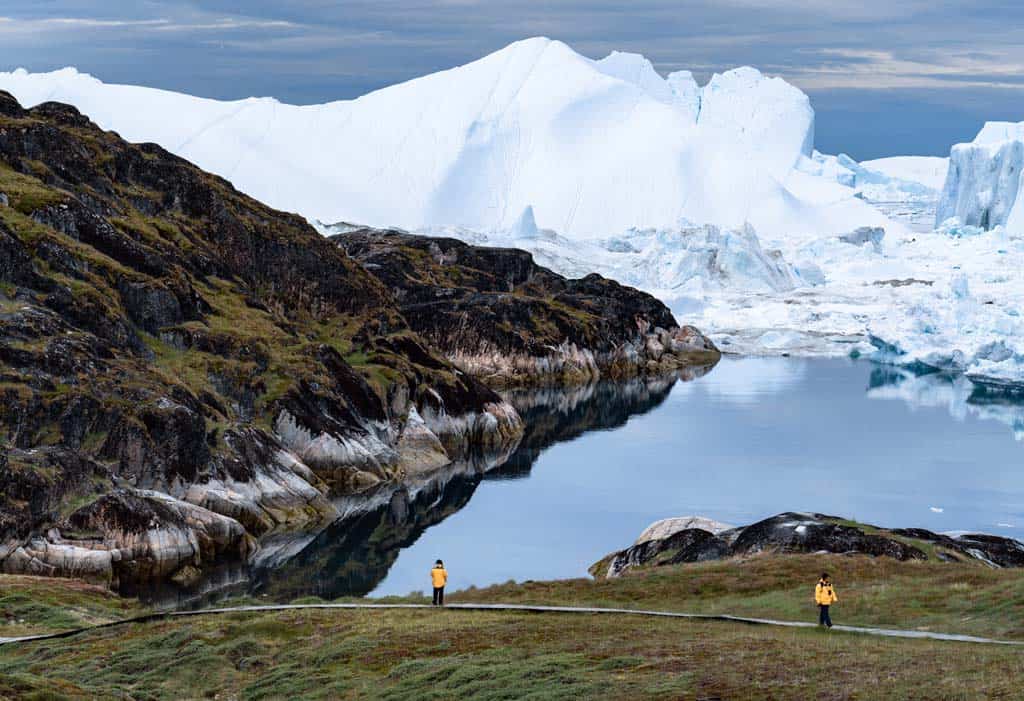
Zodiac Cruises
As beautiful as the MV Ultramarine is, it’s much nicer to be out on the water navigating between huge icebergs and entering narrow coves in search of wildlife and hiking trails.
Every opportunity that Christina, the expedition leader, had to deploy the zodiacs and get the guests off the ship he jumped on. And we’re so glad we did.
Almost every day we would head out in the zodiacs, either to visit the communities, jump onto shore to go hiking or to just cruise around the stunning landscapes of the Northwest Passage and Greenland.
The expedition team at Quark are very experienced at driving zodiacs, having undertaken a huge amount of training in navigation, rescue and ocean/ice safety.
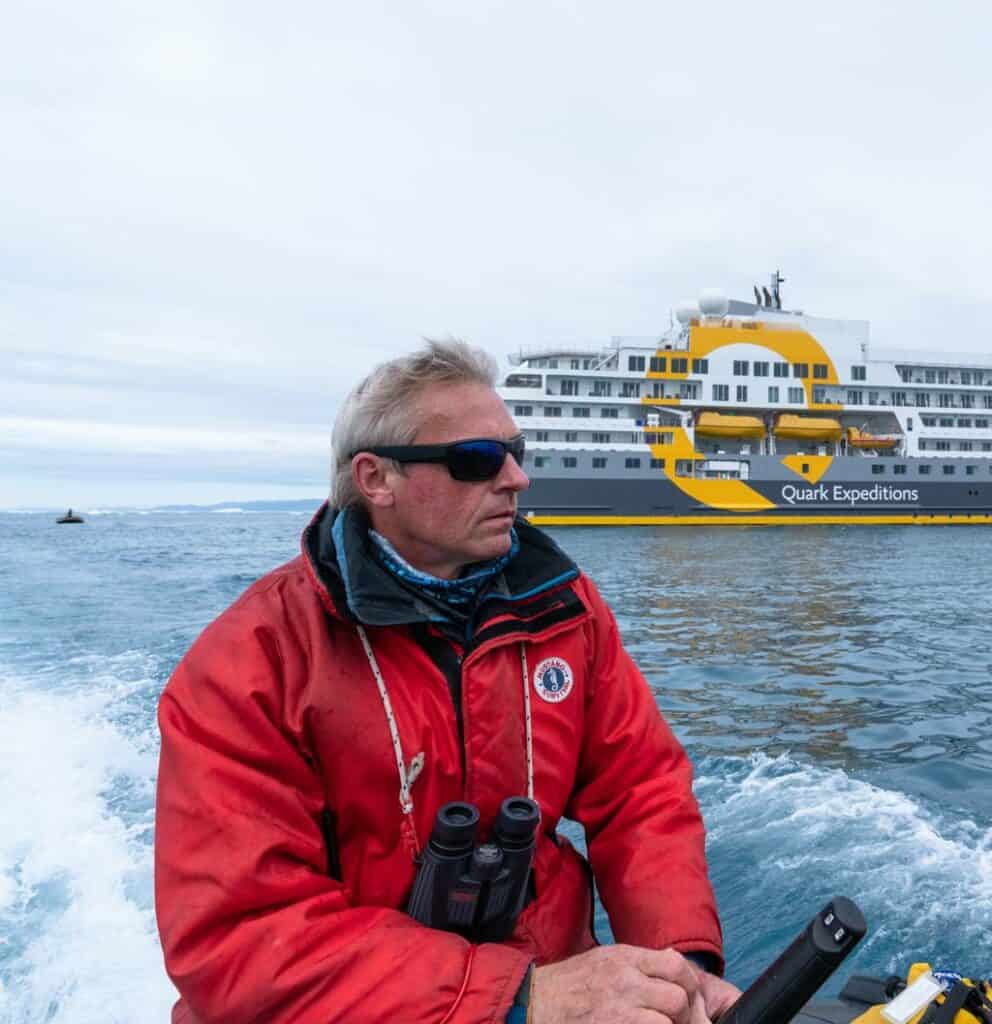
For us, one of the best elements of the entire Northwest Passage: In the Footsteps of Franklin adventure was having this opportunity to see the towering rock formations and glistening icebergs from the water’s level.
In Disko Bay we zipped between huge chunks of ice and even had humpbacks breach right next to our zodiac.
Between Pond Inlet and Arctic Bay we cruised along the base of the most spectacular geological formations we’ve seen this far north.
In the middle of the Davis Strait we dropped the zodiacs and quietly motored amongst the sea ice in search of seals, walrus and polar bear.
After a pod of 30 orcas surrounded the ship we waited until they were at a safe enough distance away that we wouldn’t disturb them, then headed out in the boats to check out the most spectacular icebergs we’d come across, while also keeping an eye out for the elusive whales.
With the Ultramarine’s ability to deploy the zodiacs in a matter of minutes and 3 sides of the ship for entry and exit points, it means no opportunity is ever lost when it comes to zodiac cruises.
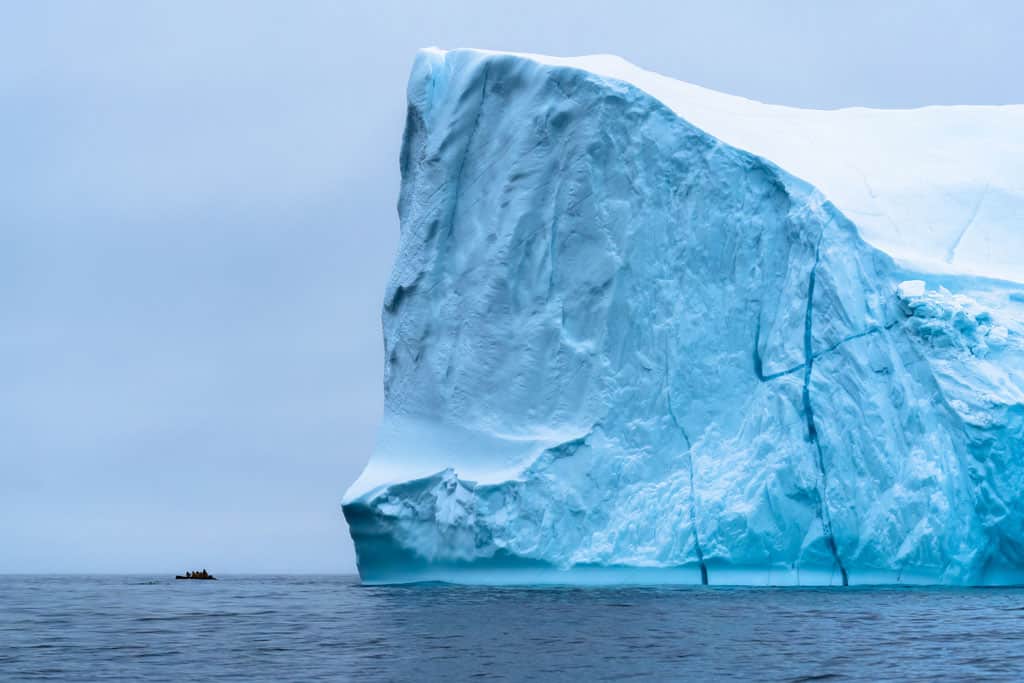
History Excursions
Of course being in the ‘Footsteps of Franklin’ means a large focus of the voyage was to follow in the path of the great explorer.
The ultimate goal is to visit many of the places that Franklin and his team stepped foot, as well as learn about the history of other important elements in modern Arctic history such as RCMP stations and missionary movements.
Dundas Harbour
We stopped off to explore Dundas Harbour on one of our last days in the Canadian Arctic.
Located on Devon Island, Dundas Harbour is an abandoned settlement in the province of Nunavut along the Northwest Passage.
This area was once inhabited by Inuit people in 1933 and after 13 years of trying to live in this harsh and isolated environment, they later relocated back to the mainland.
Then in the 1940s, the Royal Canadian Mounted Police placed an outpost here. But sadly the conditions again were harsh and lonely.
Many of the RCMP placed here found it extremely hard to live and the outpost was closed in 1951.
Now only the ruins remain of the building and a Northwest cemetery with Inuits people, RCMP people and explorers that may have passed in the area exploring.
Having Ken (a polar historian specialising in the Northwest Passage) and Laurie (one of the world’s greatest living explorers) with us on the Ultramarine to explain what had happened helped us understand the area much more.
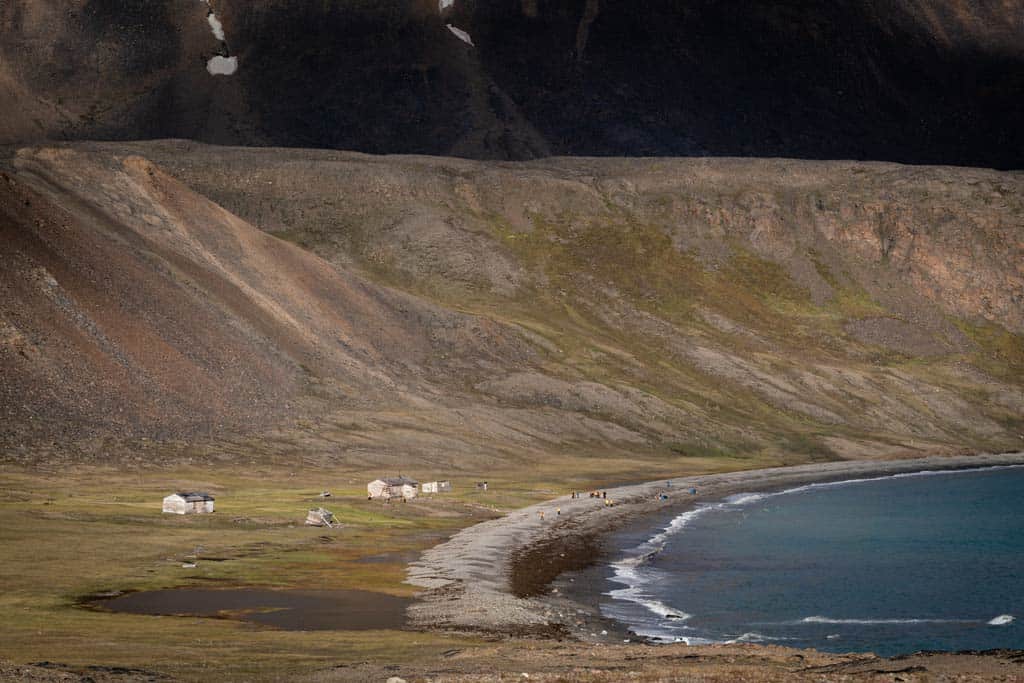
Beechey Island
This is one of the historical stops the Quark Expeditions Northwest Passage trip does.
Unfortunately we did not make it this far, but I have added it to our Footsteps of Franklin review as it was an important location.
Beechey Island is located in the Wellington Channel in the middle of the Arctic Archipelago in Nunavut.
This place played an important role in the explorer Sir John Franklin‘s journey.
This is the bay where John Franklin’s ships, HMS Erebus and HMS Terror were based as they were protected by their first winter while exploring the Northwest Passage.
Three graves of Franklin’s expedition team members were found on Beechey Island in 1850.
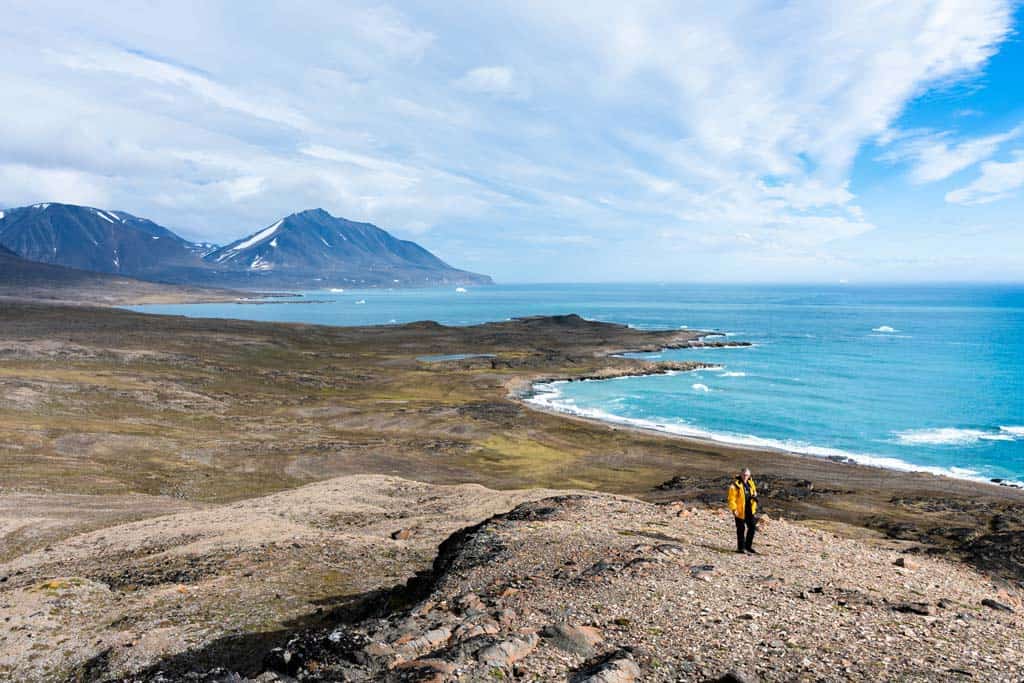
Amazing Wildlife Encounters
For most people, us included, a highlight of any trip to the Arctic is seeing the unique species of wildlife that is found this far north.
Of course any wildlife sightings are never guaranteed, and just because whales were seen in one particular bay one morning doesn’t mean they’ll be there a few hours later, so every encounter should be celebrated.
On our particular voyage across the Canadian Arctic we didn’t have an abundance of wildlife encounters, but the ones we did have were very special.
Polar Bear
Our biggest dream in the Arctic was to see a polar bear, and we were so lucky to actually see one near the end of our trip!
As we mentioned above, as we were navigating through some sea ice on the Davis Strait one of the experienced guides, Farbrice, was standing on deck looking out for wildlife.
We asked if he thinks we will see a polar bear. He said it is unlikely as the ship was too far from the coast, but that it was worth keeping an eye out just in case.
Well blow me down, in the middle of nowhere and on all of the chunks of ice in the entire Baffin Bay, there she was sleeping on some sea ice.
She was right at the bow and so close as we passed her. She was very unsure of the ship, and Fabrice called the bridge immediately to get the captain to slow down. She jumped off as we cruised by her sea ice and she swam to the next one.
Polar bears are great swimmers and can swim long distances. One has even been recorded swimming between Svalbard and Norway, a distance of nearly 500 miles.
Seeing the teenage, female polar bear was one of the biggest thrills of our lives.
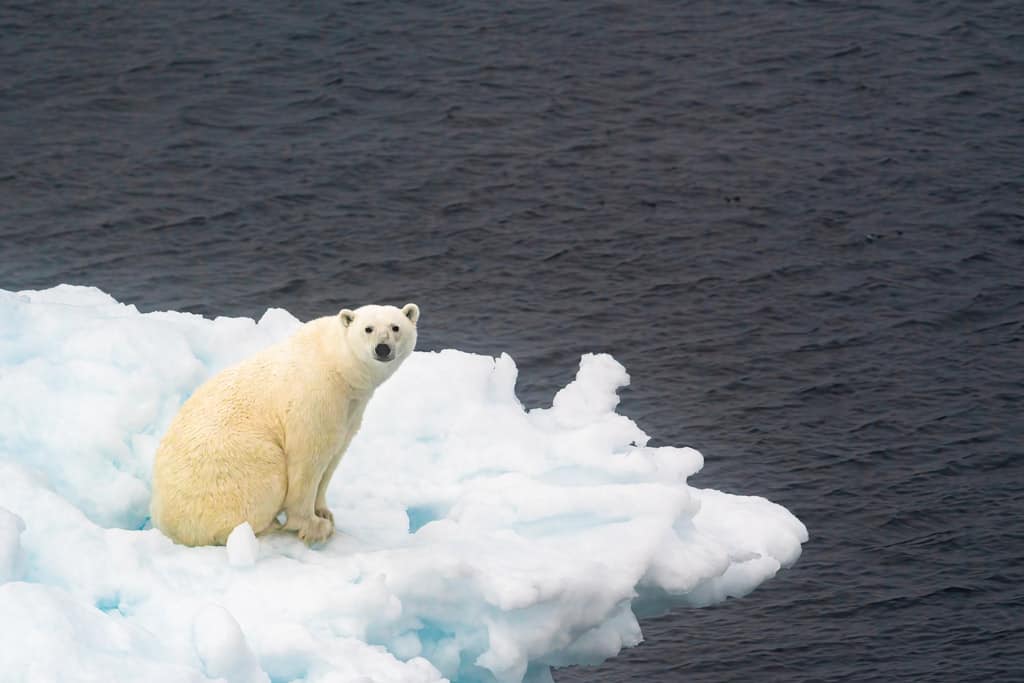
Orcas
Hanging out in the Panorama Lounge is the place to spot wildlife. On our crossing from Greenland to Canada along the Davis Straight, the most incredible thing happened.
A pod of about 30 orcas popped up right next to our ship and followed us for about 45 minutes! It was so beautiful and humbling to see these gorgeous and enormous mammals so close.
With such a long amount of time too we all had the chance to put the cameras down and simply watch them swim and breach in unison, with the big males staying out the back to keep an eye on the pod.
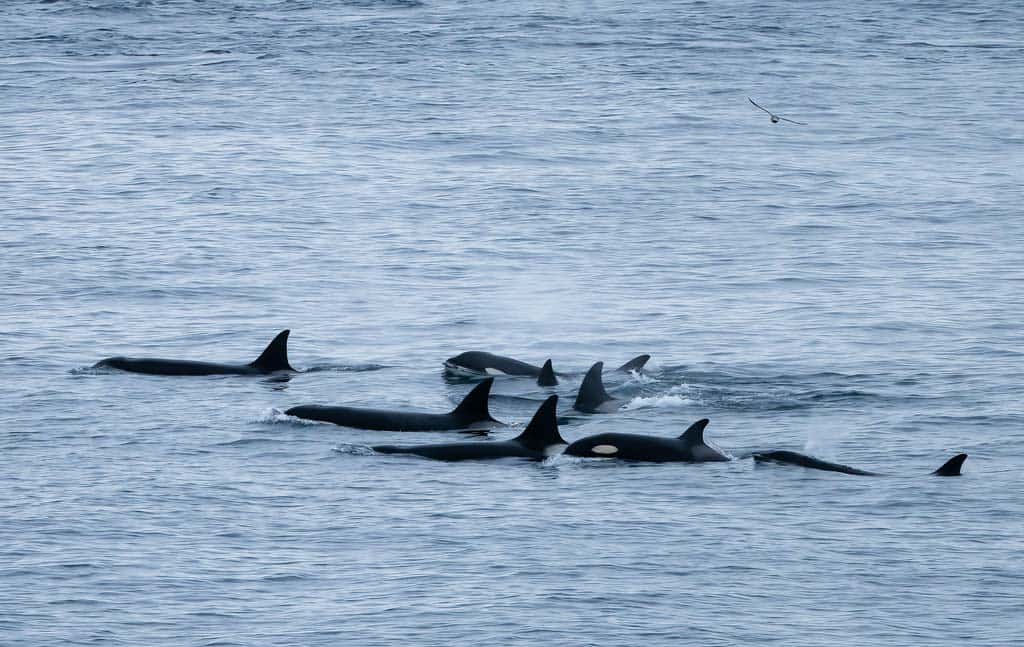
Humpback Whales
During a zodiac cruise in Disko Bay, just in front of the ice fjord in Ilulissat, a small pod of humpback whales appeared less than 100m from our boat.
These beautiful creatures breached and dove for a few minutes, showing us their large flukes before disappearing into the depths.
We’ve been lucky enough to see humpback whales in Antarctica and Australia, and the thrill never goes away.
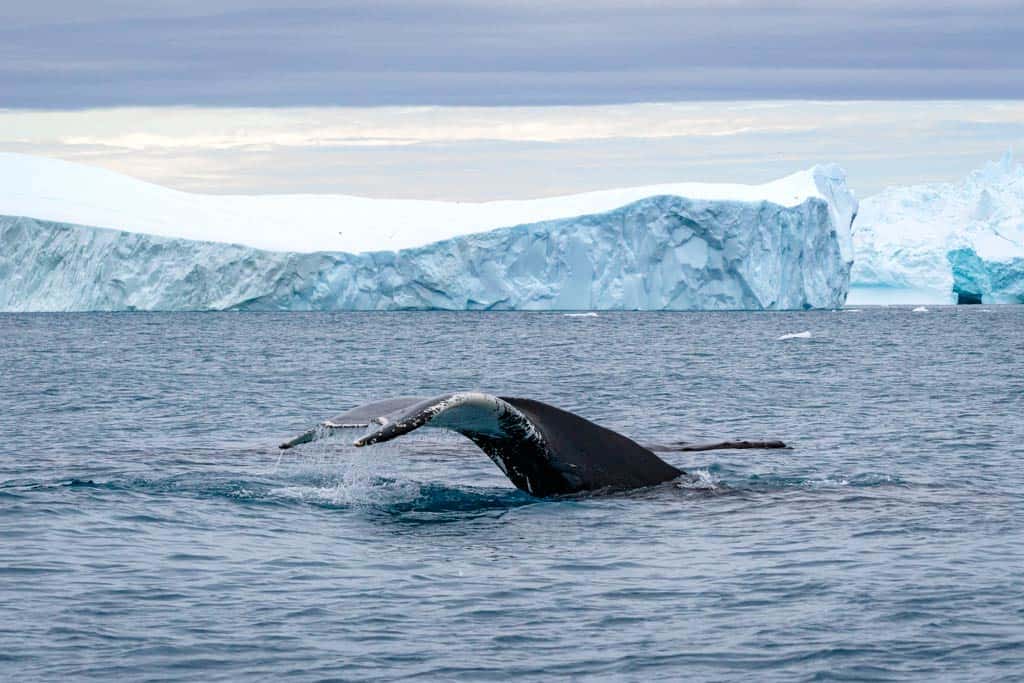
Other Animals
Besides those big 3, we also saw ringed seals, arctic tern birds, auk birds and northern fulmar birds.
Unfortunately we didn’t really see any walrus, belugas, narwhals or bowhead whales, which also frequent these waters, so maybe you’ll get luckier than us on your own trip.
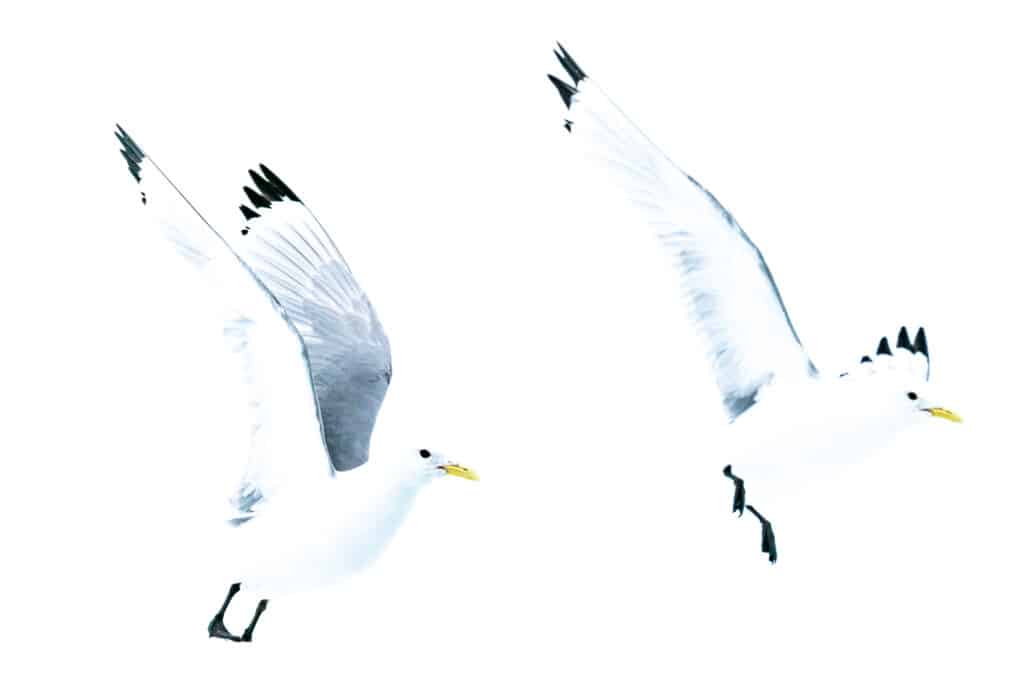
Seeing Icebergs and Sailing through Sea Ice
There’s something so majestic about seeing towering icebergs float silently in the ocean.
Depending on the time of year you cruise the Northwest Passage you may get a huge abundance of icebergs and sea ice, or there may just be scatterings of a few around the place.
If you love seeing ice, and let’s be honest, it’s so cool to see, then consider a trip earlier in the season.
Cruising Through Sea Ice
We woke up at 6am to some banging on the front of the ship. We stepped out onto our balcony and gazed our eyes across tremendous amounts of sea ice that the Ultramarine was passing through.
Knowing that the ship can handle it thanks to its ice-strengthened bow and hull, and having confidence in our very experienced captain who was cruising at a very slow speed, we weren’t concerned at all.
Instead we excitedly ran to the Panorama Deck and found many other passengers standing out there in awe.
Being surrounded by sea ice as far as the eye can see made us feel like we were actually in the Arctic!
It was everywhere. Some big, some small, some thick and some thin. It was so impressive.
Every hour that we weren’t in presentations or eating meals we spent hanging out on the Panorama Deck watching the sea ice, completely mesmerised.
We unfortunately could not get to the south of Baffin Island because of the amount of sea ice around, but this meant conditions were much better for Polar Bears and they need it more than us.
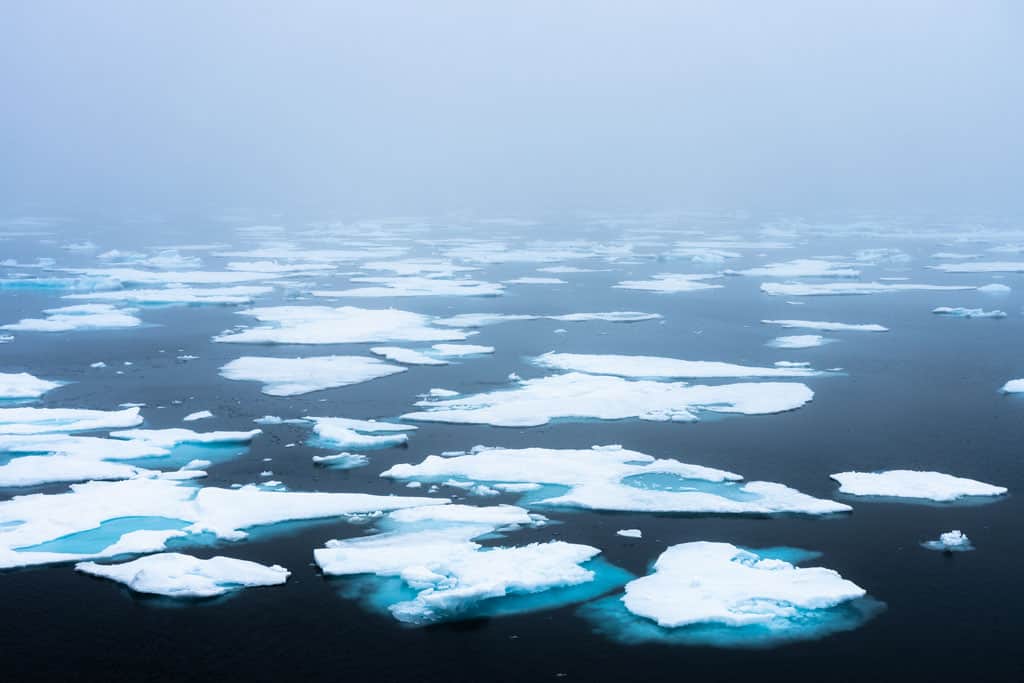
Up Close and Personal with Ice Bergs
We think that at least 30% of all the photos we took in the Arctic are of icebergs. We just absolutely love them.
Every single day of our Northwest Passage cruise we saw dozens, or hundreds, of icebergs and it never got old.
We saw them from the ship, from the zodiacs, washed up on beaches and calving from glaciers.
But did you know there are different types of icebergs depending on the size? We didn’t until this trip!
First, the general term ‘iceberg‘ is when a bit of ice breaks off from glaciers or shelf ice and is floating in open water.
The smallest is called a growler. They are roughly the size of a car or grand piano and are smaller than 1 meter in height.
Bergy bits are the medium-sized chunks of ice, with their height being greater than 1 metre up to 4.5 meters.
Icebergs are the largest and go from 5 meters high to more than 100 metres above the sea surface. They are definitely the most impressive.
The first 3 photos show the three types. The rest are just some of our ice shots from the Arctic.
Thanks to Jodie, the onboard glaciologist with Quark for teaching us all about icebergs!
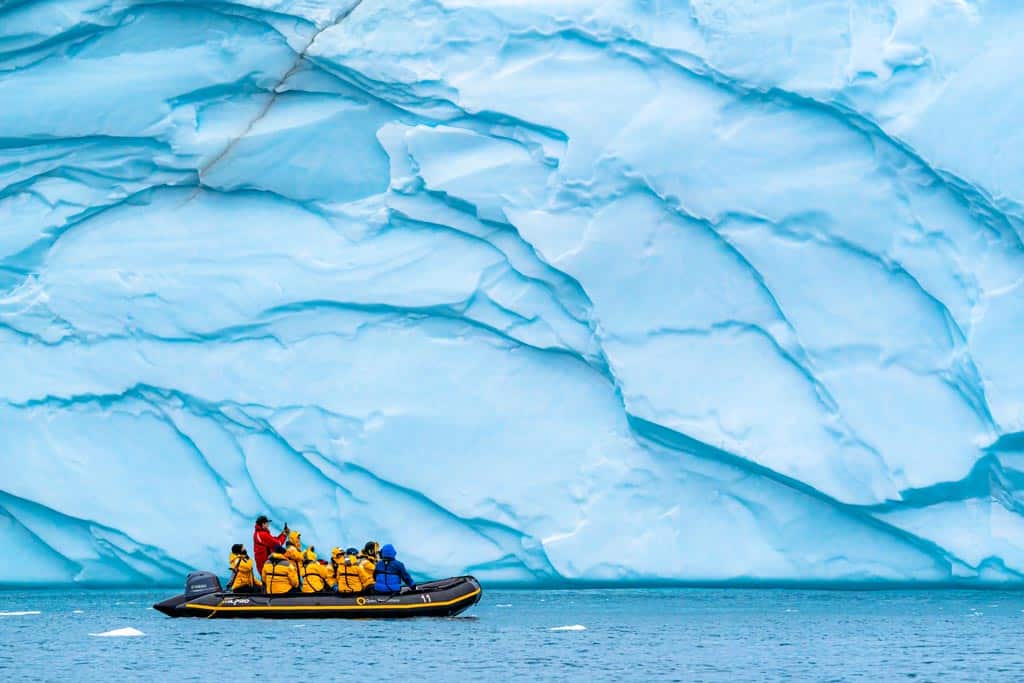
Presentations by the Quark Expeditions Team
When we weren’t on the decks or out on excursions, we also got a chance to listen to presentations from our Expedition Guides on board.
We heard from marine biologists, ornithologists, scientists, an Arctic historian, an Inuit leader and adventurers.
Learning about the Arctic, its people, wildlife and history while navigating towards the Northwest Passage was such a special treat.
There were so many amazing presentations on the vessel during our Canadian Arctic trip.
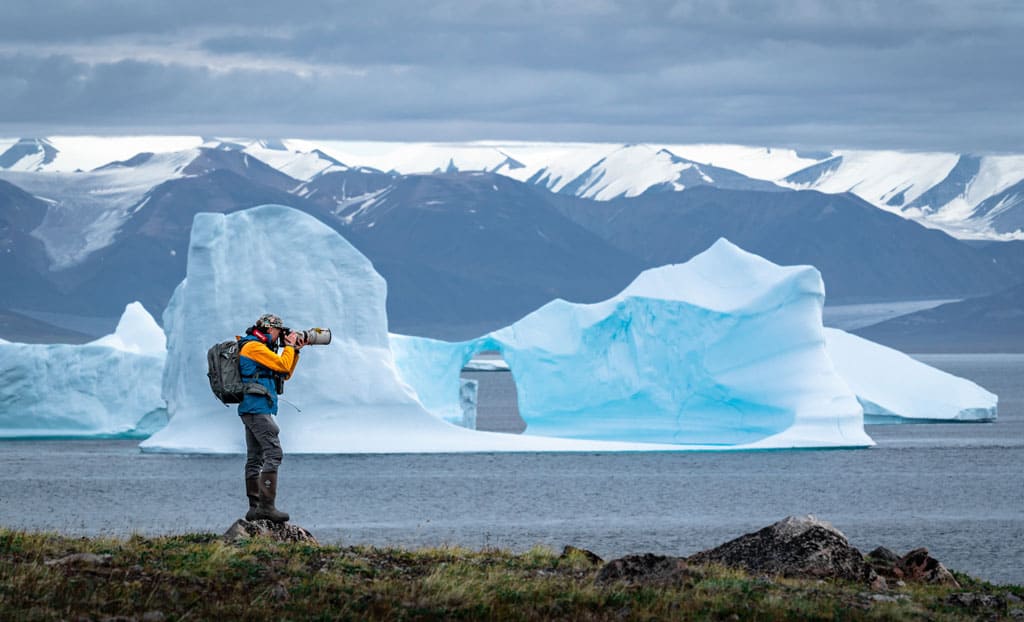
They are usually held in the Ambassadors Lounge and went for about 45 minutes each. All were so fascinating and should not be missed.
If you are not feeling well, you can view these presentations live-streamed from the comfort of your own room on the television. But we highly recommend being in the room to take it all in.
In our Northwest Passage: In the Footsteps of Franklin voyage we had an Inuit man, Wayne, who spoke about his culture.
We had a historian onboard, Ken, who spoke about the history of John Franklin’s journey through the Northwest Passage.
We had a glaciologist, Jodie, onboard talking to us about the glaciers, sea ice, icebergs and the effects of climate change.
We had a few ornithologists, Adrian and Noah, who are bird experts and their passion for birds made us all love them even more.
There was a marine biologist, Sam, who was an expert with marine animals and never stopped sharing his knowledge and hilarious stories with the guests, making him a crowd favourite.
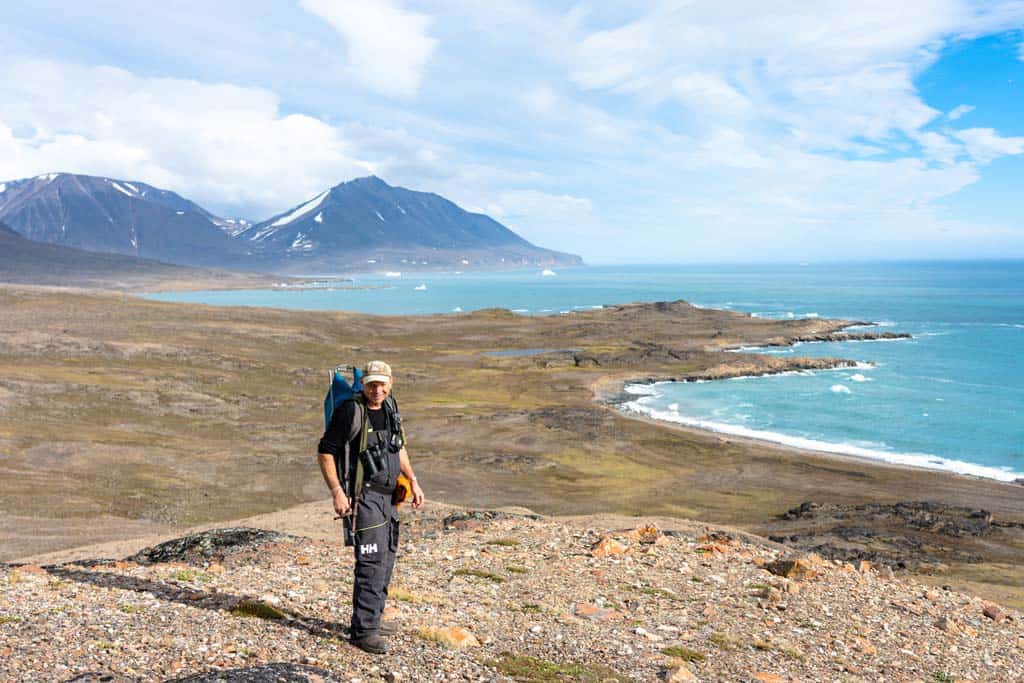
A massive thank you to Ken and Laurie for diving deep into the history of Sir John Franklin and his crew. The history sure is fascinating in this part of the world.
Ken and Laurie dove into a section of the Sir John Franklin 1845 expedition to find the Northwest Passage.
They talked about Franklin’s previous adventures and unfortunately how all the crew perished on the Northwest Passage. Their knowledge is incredible, and the trip would not have been the same without them.
A big special thank you to Wayne (an Inuit man from Canada) who gave us a fascinating insight to growing up in the region when he was young and the connection he still has with his people and land today.
Travelling to the Arctic includes the people and culture, not just wildlife and landscapes, and we’re so thankful to have had Wayne with us.
Finally, a special shout out to Christian, our expedition leader, who superbly plotted our voyage us around the Arctic and made the most of all weather, sea and logistical conditions that arose.
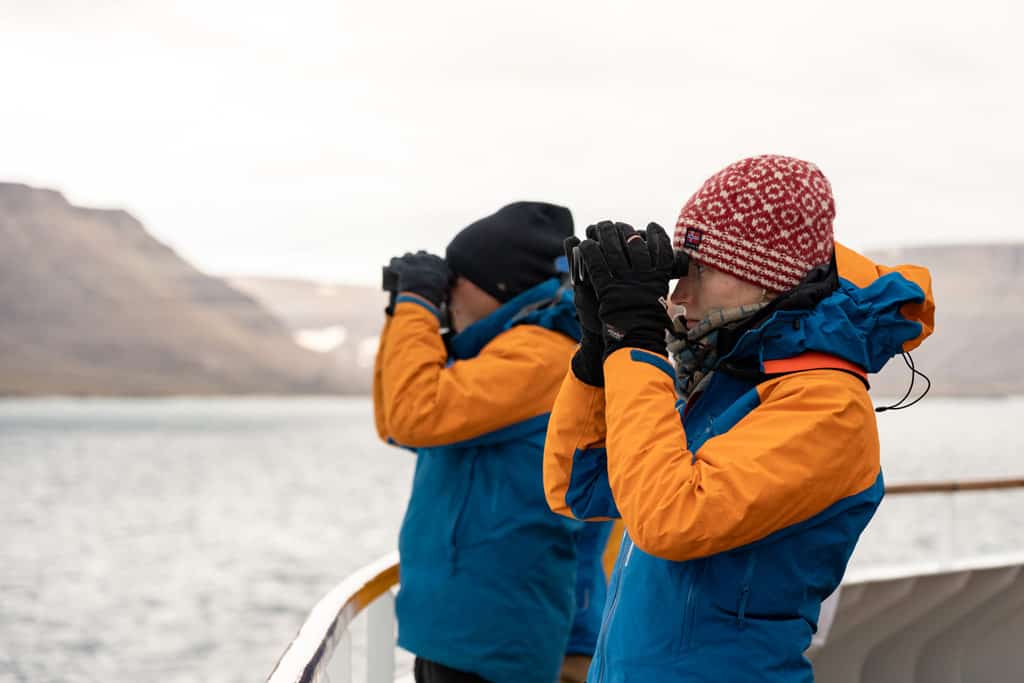
The Ultramarine Staff
We want to give a massive shout out to the staff on the Ultramarine vessel.
While the destination and experiences were obviously the drawcard, the crew really made the trip for us. Without them it wouldn’t have been the same.
One thing we would highly recommend on these expeditions is to get to know the staff.
They are on the ship for months at a time and work so hard to provide amazing service to the guests.
We appreciated every single one and had so many amazing conversations with them.
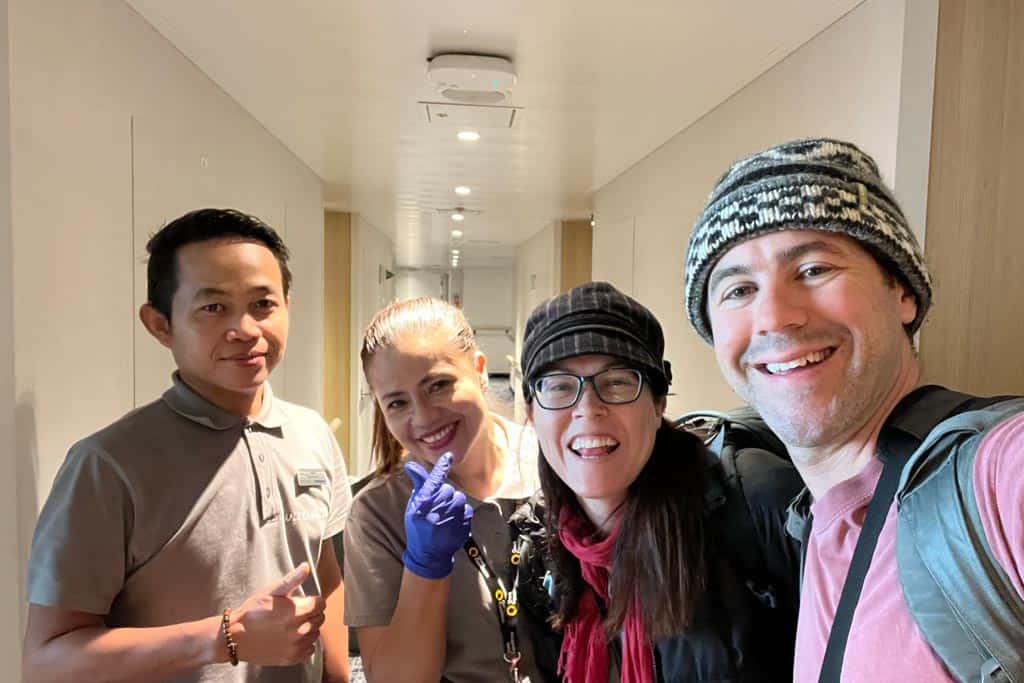
The restaurant staff take the time to get to know each person and their dietary requirements so well. Their memories are amazing.
We even asked if they had the guests’ photos out the back in the kitchen with each dietary requirement. They laughed and said no, we just take mental notes.
Thank you to every staff member from the engine room to the bar on the upper deck and everyone in between.
And to our room attendant, Nieves, who was a bundle of joy and constantly checked in on us to make sure we’re ok throughout the 17 days. You are so special and we can’t thank you enough for everything.
We know we’ve forgotten lots of names but you were all superb. Can’t wait to meet you all again somewhere in the world.
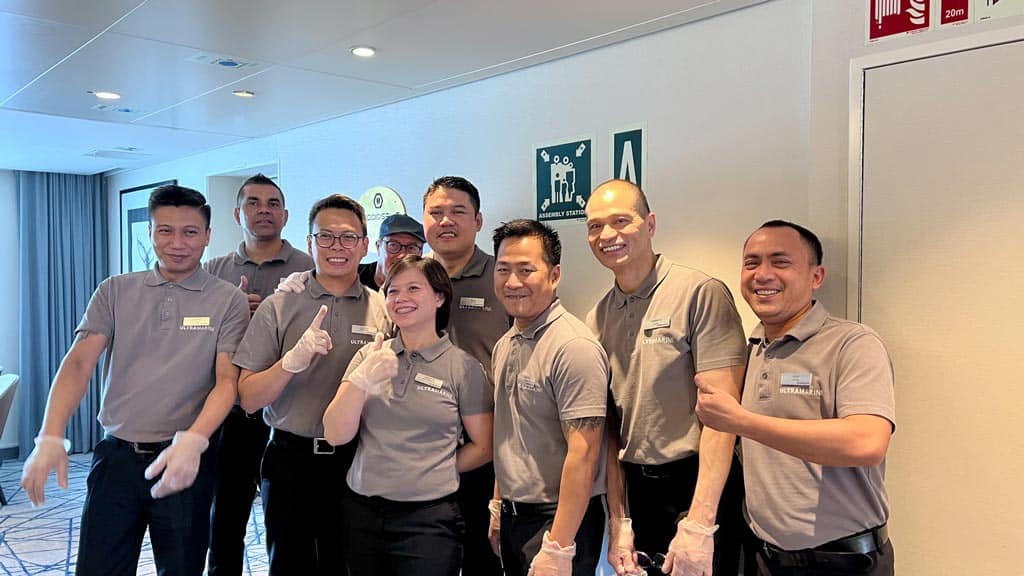
Dining and Bar Experience on the Ultramarine
No, you don’t travel the Northwest Passage to eat and drink. But of course it plays an integral part of the experience, and lucky enough Quark Expeditions ensure that all guests are fed like kings and queens.
The Food
The food was amazing with a huge variety of delicacies, regions and styles each day.
The meals were either served buffet style for breakfast and lunch or a la carte for dinner.
No dietary requirement was too hard for the chefs, catering for allergies, gluten free, lactose intolerant, vegans and vegetarians.
For breakfast there is always an omelette station, a porridge and bread/pastry station, fruits and hot dishes like bacon, sausages, pancakes, potatoes and baked beans.
All the bread and pastry are baked daily on the ship by the dedicated pastry chef.
If you do not fancy the breakfast buffet, that is no problem at all. There are daily specials that you can order too.
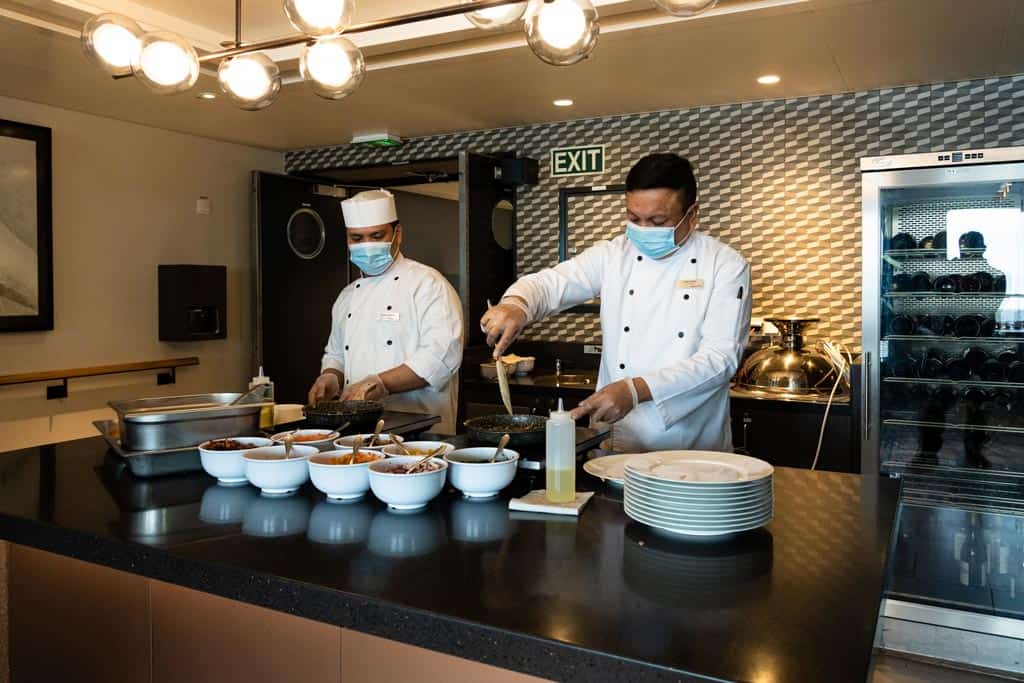
For lunch, there is always a salad bar, soup station and the dessert corner, as well as a hot food station that changes daily.
There are several options from curries to stews to fish and chips to roasted vegetables to meat dishes.
Sometimes they would have either a sushi, pizza, pasta or Mexican station set up. These are on random days and were a lovely surprise.
In the evenings we would have a menu to choose from with 3 options per meal (starter, soup, main and dessert), with the main course usually including choices from red meat, chicken, fish and vegetarian.
You could have as much as you would like or as little as you want. There is a separate vegan and vegetarian menu also, you just need to ask the staff at lunch for it. By organising this at lunch they will prepare your special order for your dinner.
And the desserts…Oh my gosh, the desserts were to die for and we just couldn’t say no to them.
You will never be hungry. The food was all so delicious and we actually put on weight during our time on the ship!
Do not miss the end-of-voyage presentation about how the ship does their food orders and how much they get for each journey. They take you through the gully and show you around the kitchen. It is very impressive.
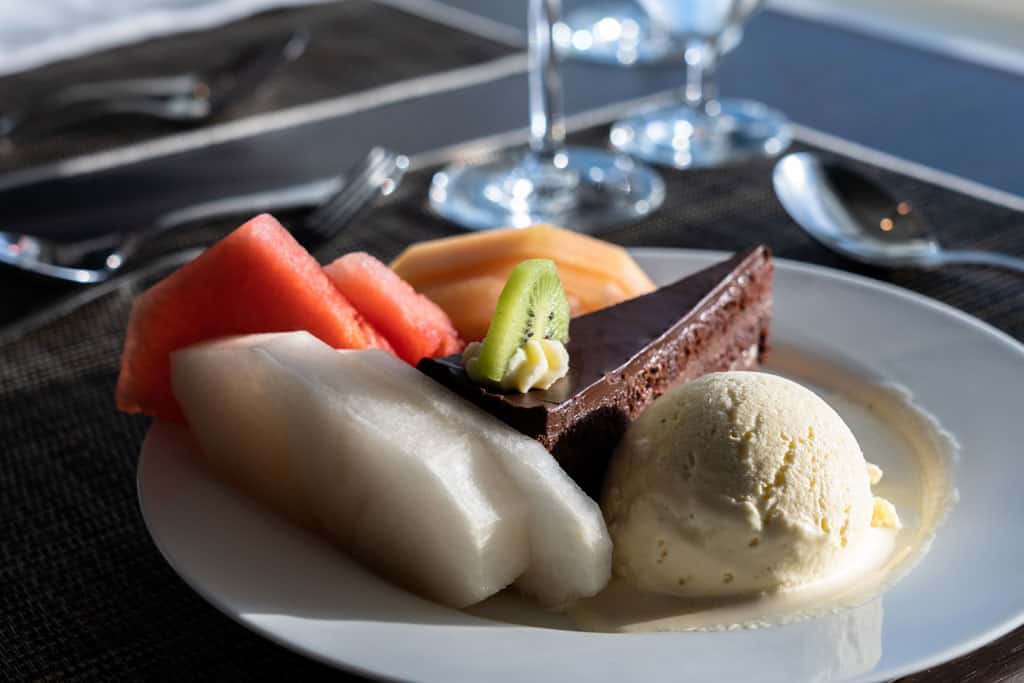
Drinks
As for drinks, coffee and tea are always included in all meals. There was a coffee and tea station up in the Panorama Lounge for the guest to use whenever they would like 24/7.
Soft drinks are always available at the bars or in the restaurant. This is included too.
Wine and beer are included in the evening dining meals. You can choose from red, white and sparkling.
With the beer selection, the staff will let you know, but we found a varied selection of standard beers (think Corona, Heineken, etc), as well as craft beers from Greenland and Canada.
After dinner, wine and beer are available at the bars at the guests’ cost. They do have drink specials daily that are advertised at the bar and these were actually very reasonably priced.
Spirits and cocktails are available at the bars. They have a great selection and whip up some great cocktails. These drinks cost extra.
The Panorama Lounge is a great place to socialise with other guests and expedition staff members.
Every expedition staff member had an interesting story, and it was so nice hearing about all their adventures over a cold beer.
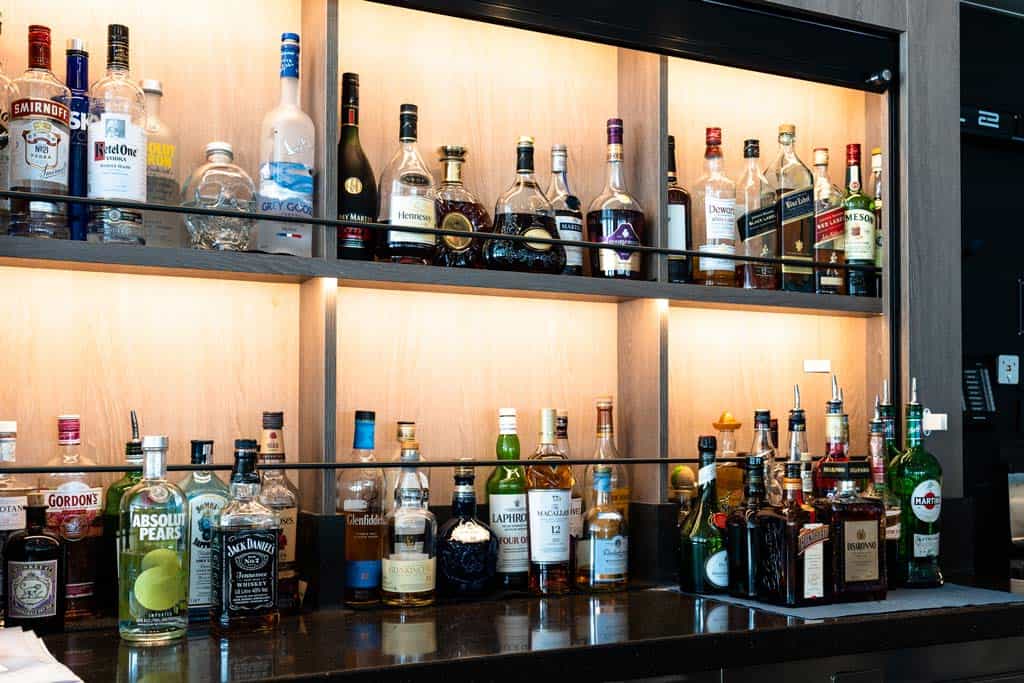
About Quark Expeditions Polar Ship – MV Ultramarine
We travelled to the Northwest Passage on Quark Expeditions’ newest ship, the MV Ultramarine.
It’s been purpose-built for polar expeditions, and designed to give guests and crew the best, safest and most comfortable experiences possible.
There’s a maximum of 199 passengers onboard, so it passes polar regulations for how many people can explore the regions at the same time.
Essential for the best way to travel in the Arctic and Antarctic.
It’s also very sustainable, using special systems that convert waste into energy, minimise fuel consumption and can navigate in narrow passages without impacting the land or seabed.
We’ll be putting together a full ship tour video, but in the meantime here’s some pics of the Ultramarine. Talk about adventuring in comfort!
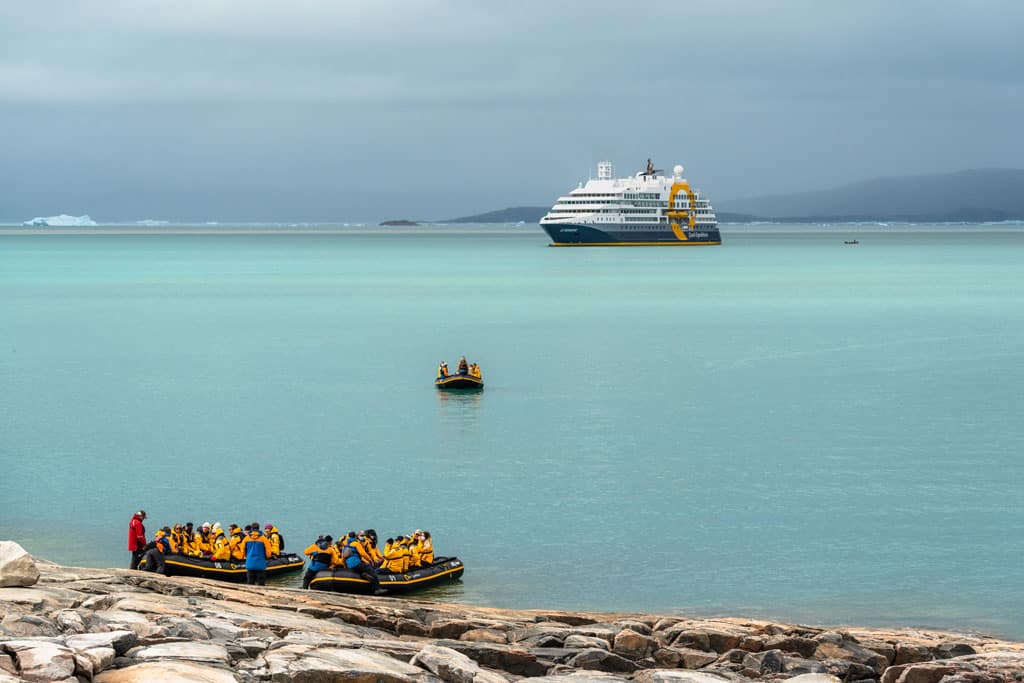
Verdict on Quark Expeditions Northwest Passage: In the Footsteps of Franklin Voyage
Our trip in the Canadian Arctic was an incredible experience. We took so much away from this trip and feel so privileged to have explored such an amazing part of the world.
Even though plans changed on our itinerary and we missed a few places due to weather, sea ice and some other logistics, we felt like we saw a spectacular amount of things and even got to see some highlights that we normally wouldn’t have seen.
This is just part of travelling to the polar regions on an expedition. You need to go in with an open mind and be ready to adapt to whatever the world presents you.
Overall we loved our time in the Canadian Arctic, following the footsteps of Franklin into the Northwest Passage.
The remoteness of the destination, wildlife encounters and the fascinating insights into local culture is something we’ll never forget.
We highly recommend this itinerary, especially if you have an interest in Inuit culture and the story of Sir John Franklin.
DISCLAIMER: Our voyage into the Northwest Passage was made in partnership with Quark Expeditions. All thoughts, opinions and millions of photos of icebergs are, as always, our own.
